- Skip to primary navigation
- Skip to main content
- Skip to primary sidebar
- Skip to footer

The Opinionated Travelogue of a Photo Maniac
- Middle East
- North America
- South America
- Pacific Islands
- FOOD & WINE
- TRAVEL GUIDES
- TRAVEL RESOURCES
- Rants & Raves
- Travel Blogger Interviews
- Contact Form
- Privacy Policy
- Featured Elsewhere
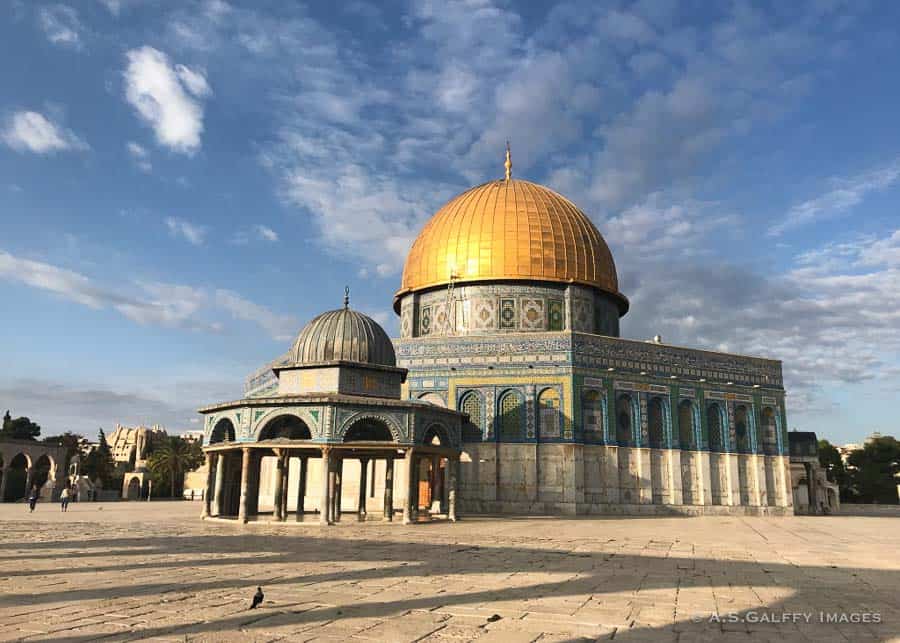

How to Visit Temple Mount & Dome of the Rock as a Tourist
Last Modified: January 20, 2024 // by Anda // 15 Comments
A visit to the Dome of the Rock and the Temple Mount was at the top of my list when I was planning our our trip to Israel . Temple Mount is one of the biggest attractions in Jerusalem , so I didn’t want to miss it. The site has been the most contested piece of territory in the Holy Land since Israel occupied East Jerusalem, in 1967.
Table of Contents
What is the Temple Mount and the Dome of the Rock?
The religious significance of the temple mount and the dome of the rock, who can visit the dome of the rock, how to access the dome of the rock, visiting hours and admission, what to expect when visiting the dome of the rock, dome of the chain, al-aqsa mosque, the purification fountain, fountain of qayt bay, how to dress when visiting temple mount and the dome of the rock, tips for visiting the dome of the rock and temple mount.
Temple Mount is a walled compound that sits above the Western Wall in the Old City of Jerusalem. The compound is the site of two magnificent structures: the Dome of the Rock to the north and the Al-Aqsa Mosque to the south.
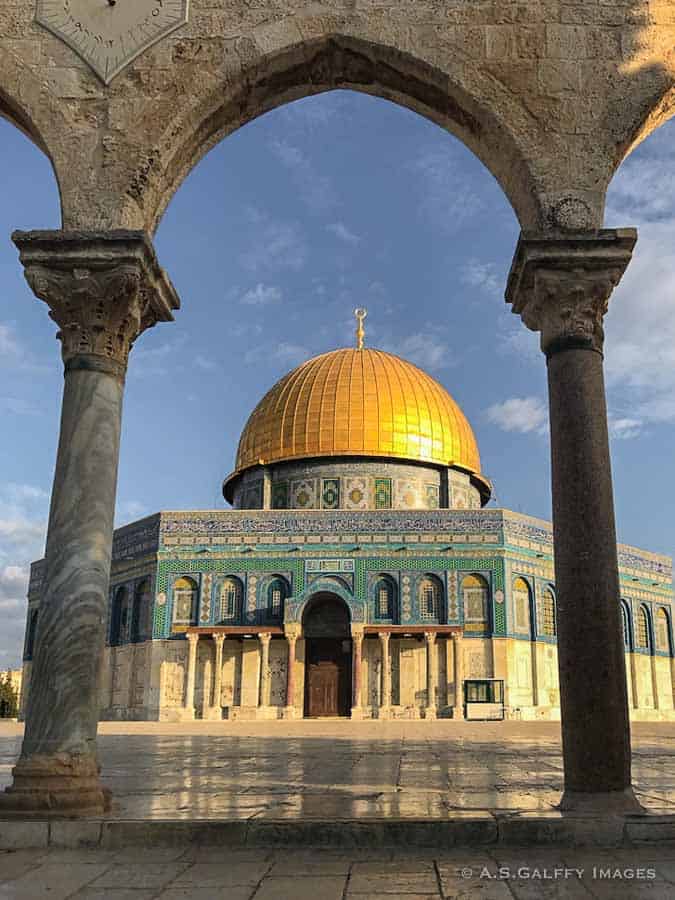
The Dome of the Rock occupies the area where the Holy Jewish Temple previously stood. The structure was completed in 692 AD, making it one of the oldest Islamic structures in the world. The Dome is a monumental building, beautifully decorated with mosaic, faience and marble. Much of these embellishments were added several centuries after its completion.
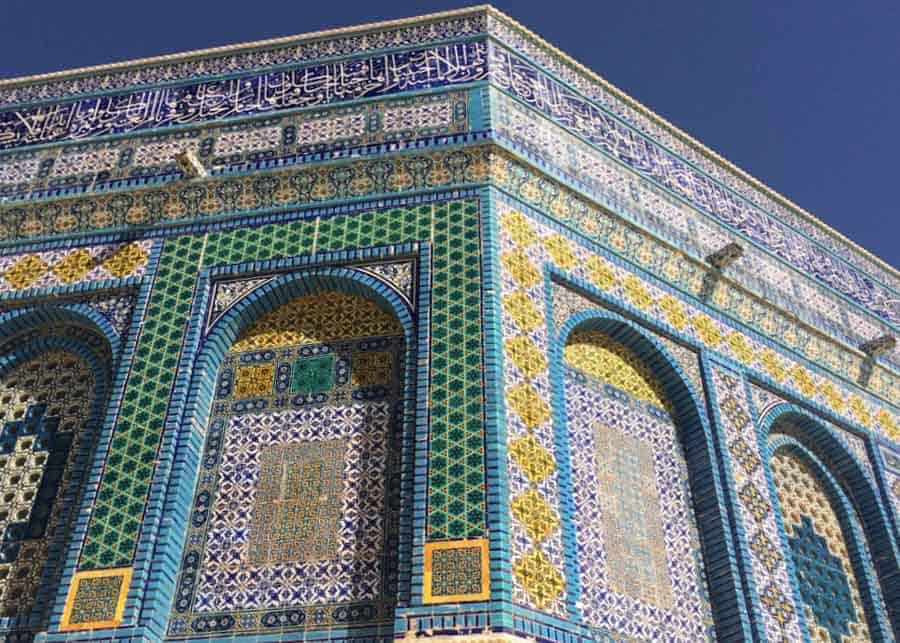
For Jews, Temple Mount is the holiest place on Earth because it’s the site where their two temples once stood. The First Temple was built by King Solomon and was destroyed by the Babylonians in 586 BC.
The Second Temple was built by Herod the Great in the 6th century BC and was destroyed by the Romans in 70 AD. Jews still continue to mourn the destruction of their temple to this day. They believe that that the temple is going to be rebuilt prior to the Messianic Age .
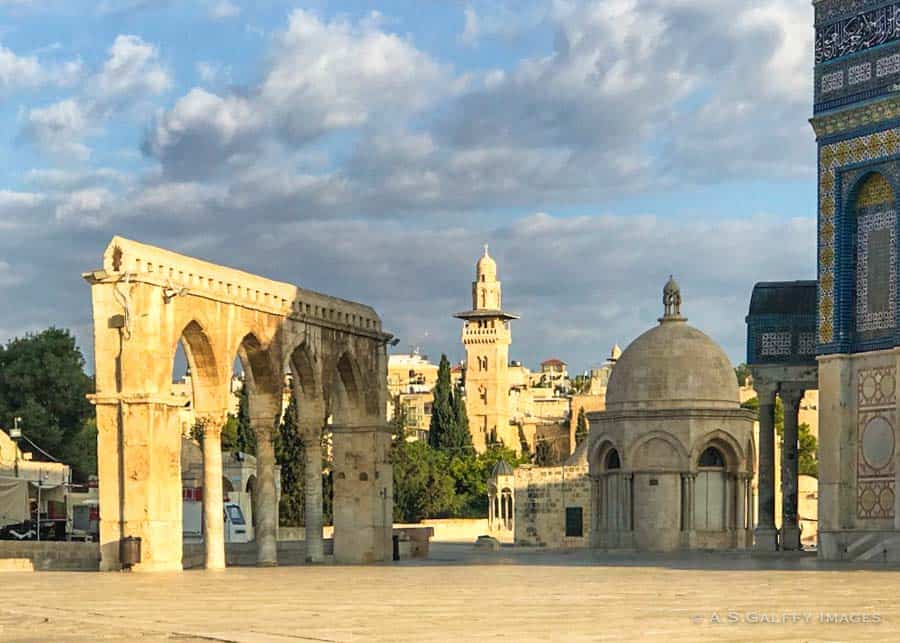
For Muslims, Temple Mount is known as Haram al-Sharif (the Noble Sanctuary) and is the third holiest site in Islam. They believe Prophet Muhammad ascended to heaven from this place in the 7th century. The Dome of the Rock was built over the Foundation Stone that marks the spot where Muhammad ascended into heaven.
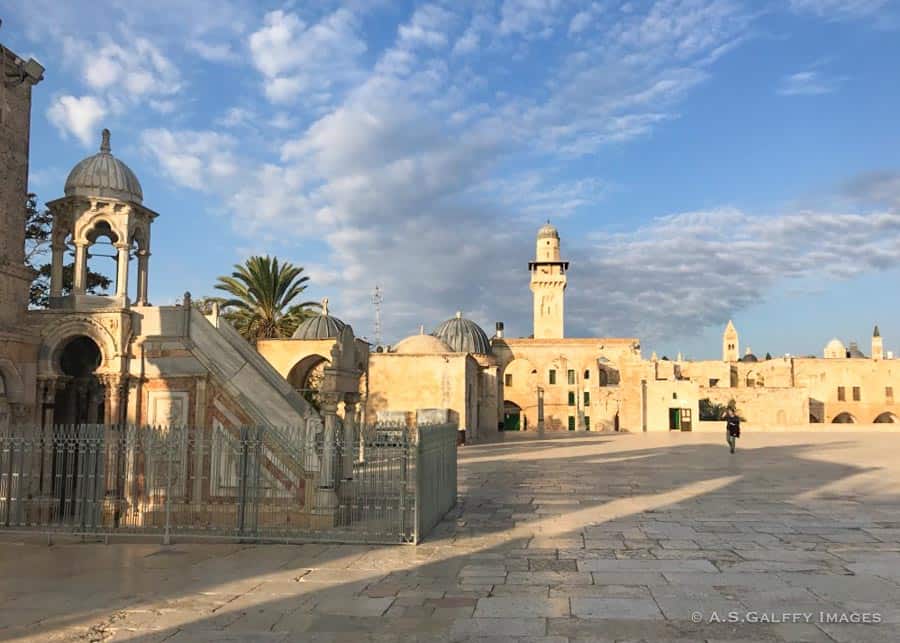
Since this place is holy to both Jews and Muslims, religious sensitivities have triggered violence, political chaos and tensions for decades. Despite the current truce, the peace is very volatile and the situation can get out of control at any moment.
Most tourists to Jerusalem want to visit the Dome of the Rock and Temple Mount. Sadly, while everybody can visit the Temple Mount complex, only Muslims can get inside the Dome of the Rock, or the Al Aqsa Mosque. As a non-Muslim, you can only visit the outside of these grandiose mosques and take pictures of them.
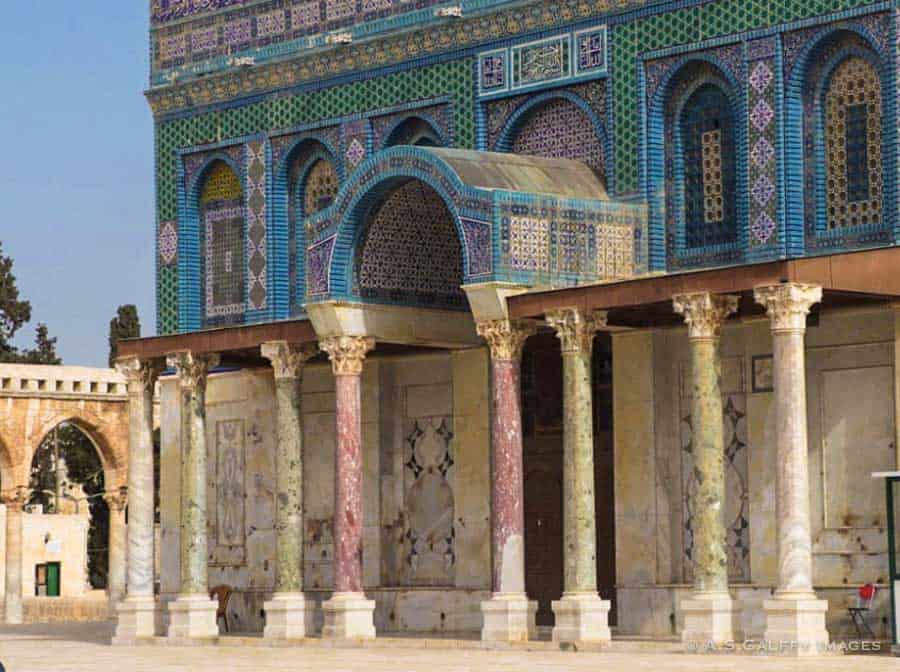
The Temple Mount is a prayer site for Muslims, who can pray here at any time. Christians and Jews may only visit the site as tourists, but are forbidden to pray on the Temple Mount.
The Dome of the Rock sits at the top of Temple Mount, which is currently under the control of the Jordanian government through the Waqf (the Islamic trust in Amman.) The Israeli government has control over the external security of the compound and can impose entry limits to the site.
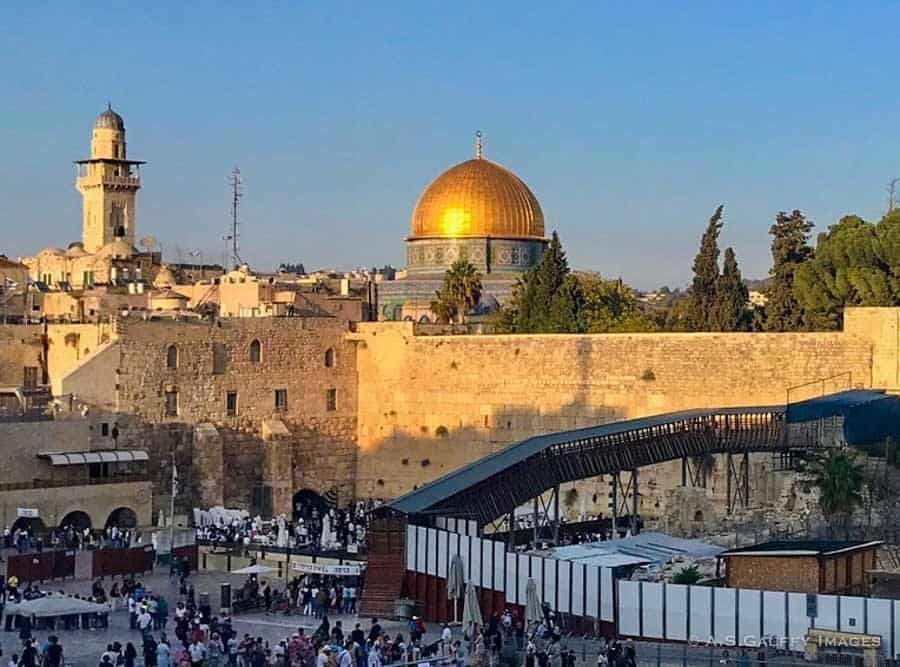
Muslims can access the Temple Mount complex through twelve gates, but tourists and non-Muslims can only enter through the Moroccan Gate which (also known as Mugrabi Gate ). This gate is located near the Western Wall Plaza, close to Dung Gate.
Admission for visiting Temple Mount and the Dome of the Rock is free. However, the site is only open during very specific times which causes very long lines.
Visiting hours for the Temple Mount are Monday through Thursday :
- Winter : 7:30 am – 10:30 am and 12:30pm – 1:30 pm
- Summer: 8:30am – 11:30am and 1:30pm – 2:30pm
The Temple Mount is closed to visitors on Friday and Saturday . It may also be closed without notice for security reasons.
We wanted to visit the Dome of the Rock without the crowds, so we came very early in the morning. To our surprise we were not the first ones in line, but at least the queue wasn’t very long.
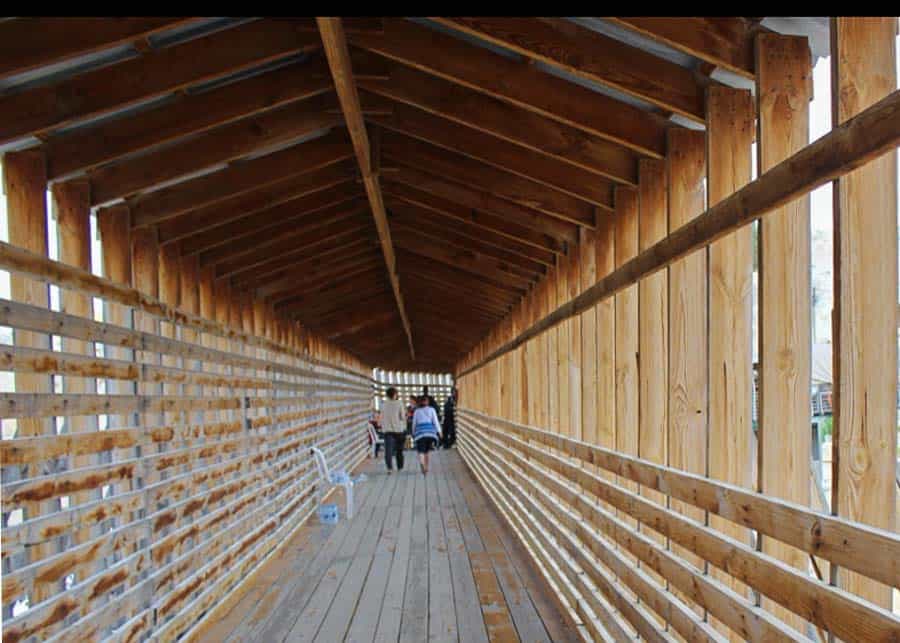
At the checking point we passed through metal detectors and had our backpacks and cameras x-rayed. They asked us if we had any prayer books or Bibles with us. We didn’t of course, so they let us pass. As we started walking up the wooden ramp towards the entrance gate, we noticed several men with semi-automatic rifles. This didn’t surpris, as military forces are omnipresent all over Israel.
Once we passed through the gate, we found ourselves in a large, open area where we could see the Al-Aqsa Mosque on the right and the Dome of the Rock on the left. It was around 7:45 a.m. when we arrived and the golden roof of Dome of the Rock was glittering the morning light.

As we began walking around taking pictures of the beautiful Dome, we noticed there many other structures around worth checking out.
Other structures to visit on Temple Mount, besides the Dome of the Rock
The biggest attraction on Temple Mount is of course the Dome of the Rock. But before rushing to the upper platform visit the Dome of the Rock, we took time to admire the beautiful arches ( qanatirs ) that frame the terrace. They have been built by the Mamluks, in the 15th century.
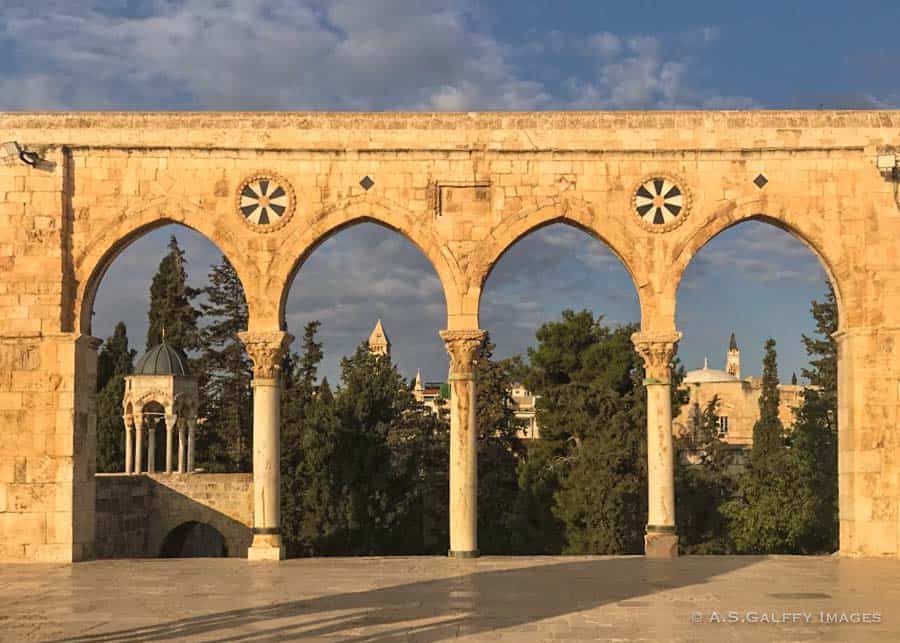
Located on the same platform and just adjacent to the Dome of the Rock, is a free-standing dome called the Dome of the Chain , which is one of the oldest structures on the Temple Mount. The dome is used as a prayer house.
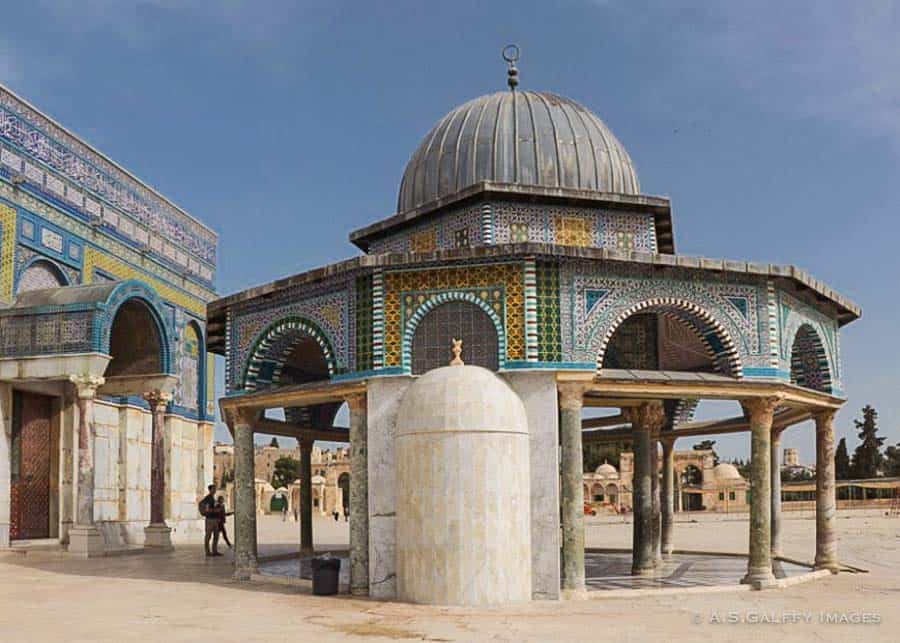
While the Dome of the Rock serves more as a shrine, Al Aqsa is a big functioning mosque that can accommodate up to 5000 worshippers at a time. It’s such a pity that we couldn’t get inside this beautiful mosque!
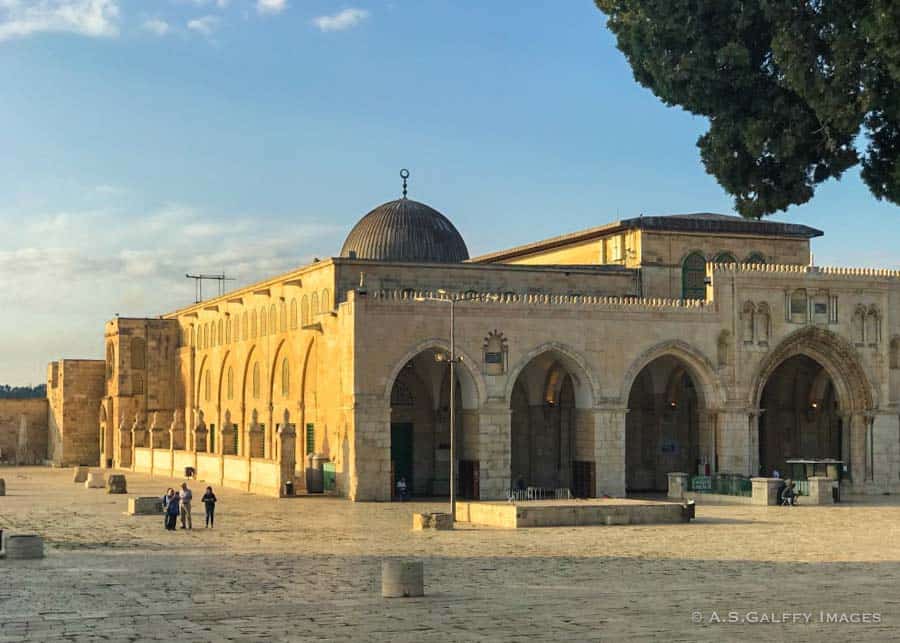
North to the Al Aqsa mosque there is a small fountain used for drinking and purification before prayers. The fountain is surrounded by a green metal fence and marble chairs.
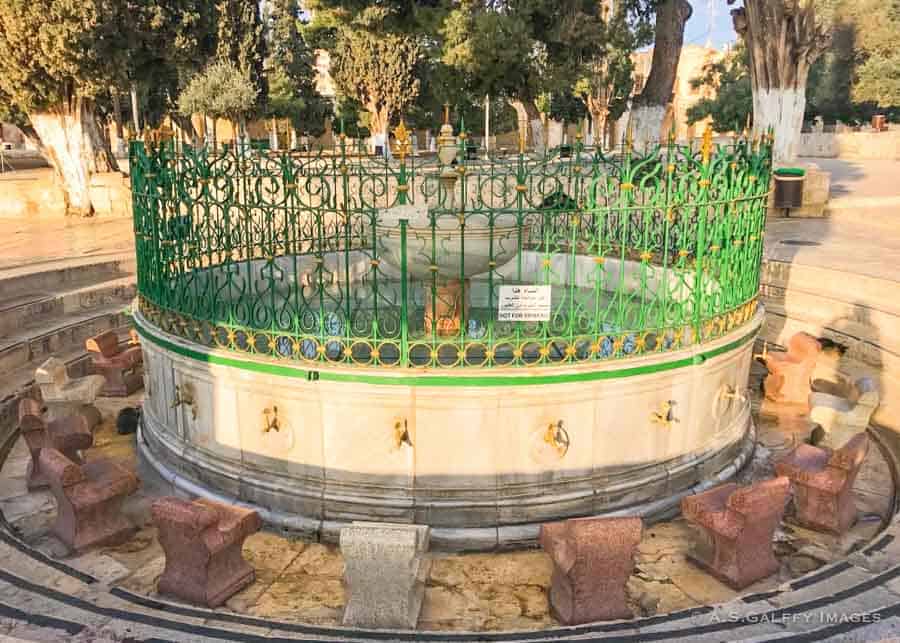
This is where Muslims wash their feet before entering the mosque. According to Islam, every Muslim must purify himself before he prays. You’ll find this kind of fountains in the vicinity of every mosque.
This beautiful domed fountain that sits on the western esplanade is very easy to miss. Compared to the Dome of the Rock, the fountain is really small but nonetheless one of the most beautiful structures on the Temple Mount.
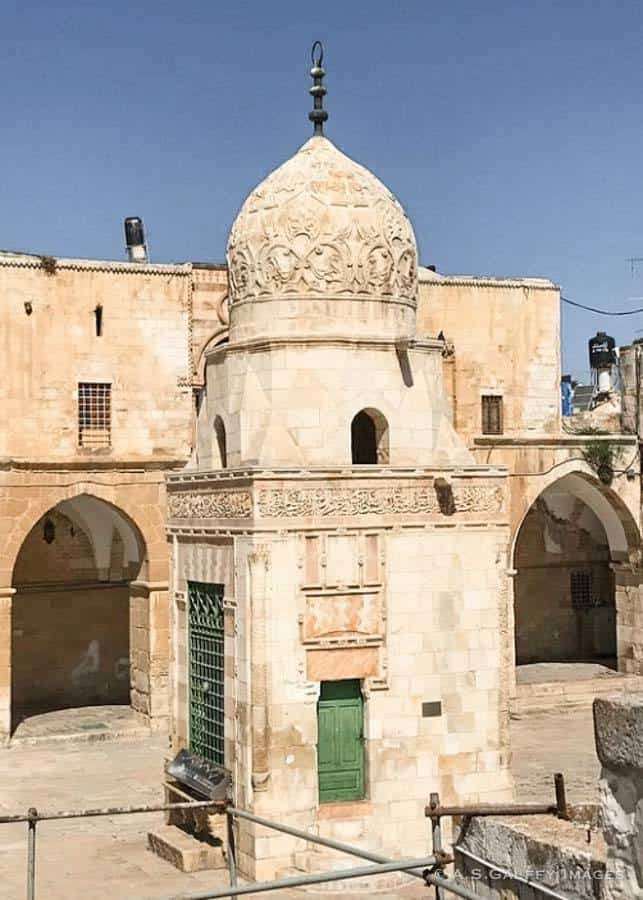
Also known as Sabil Qaitbay (in Arabic), the Fountain of Qayt Bay was built in the 15th century by the Mamluks of Egypt. Water used to pour from the shaft near the door of the fountain into ditchs below each window.
The Muslim authorities may have different requirements on different days. We friend visited Temple Mount wearing long pants and long sleeve shirts and had no problems.
Our friend visited the compound a few weeks later wearing pants and was told she needed to wear a long skirt. She had to rent a wrap from the entrance. If you know what to expect in Israel , things like these should not surprise you.
It’s better to come prepared, so bring a wrap just in case they ask you to cover your pants. Also, bring a scarf to cover your hair. They say you don’t have to do it, but you never know! I covered my hair anyway just to avoid being kicked out.
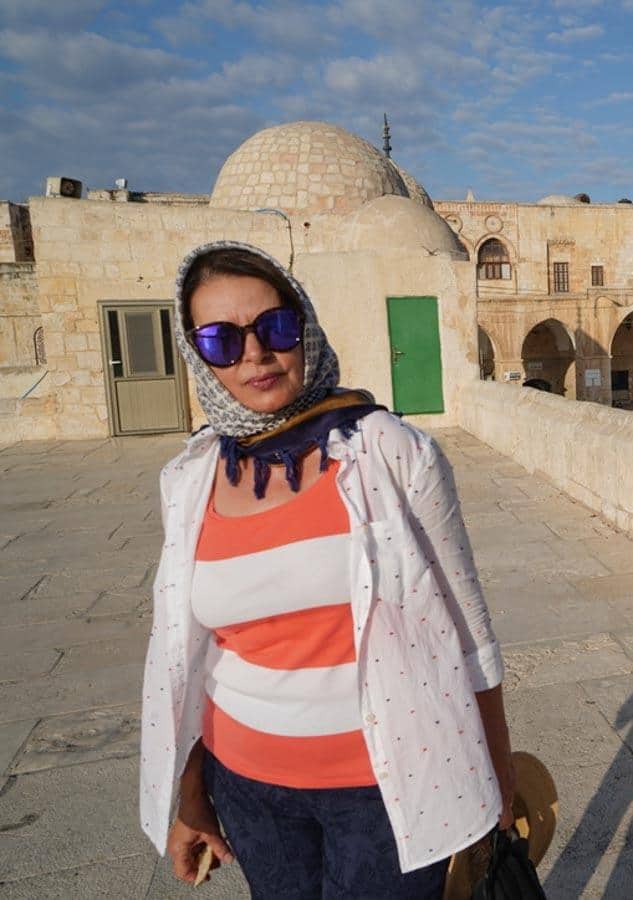
As a general rule, women should wear modest clothes that go down below the knees and cover their arms. No sleeveless shirts or shorts for men or women. Also, avoid physical contact with your partner. We have been scolded for trying to get closer together in order to take a selfie!
- Arrive early as the lines may be very long
- Bring water, sunscreen and a hat as there is very little shade around
- Dress modestly and wear clothing that covers your knees and arms
- Bring your passport for the security check point
- Don carry any Bible, prayer book, or religious artifacts with you
- Temple Mount is a holy site, so be respectful
If you enjoyed reading this post, please pin it for later:
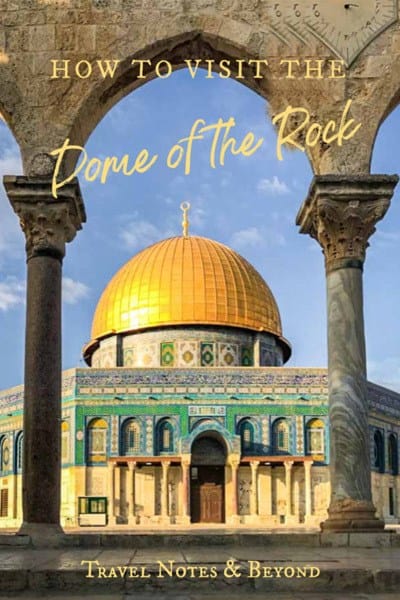
Anda is an award winning travel writer, avid globetrotter and passionate photographer. She is the voice behind "Travel Notes & Beyond," a collection of stories and travel impressions from her wanderings around the world. When she is not busy writing, traveling, or editing photographs, you can find her hiking in the foothills behind her house together with her husband and their dog.

Reader Interactions
Lilitz Palmer
October 23, 2021 at 6:41 pm
My friends are going to Israel in November and planning to go here. Where does the line start? Any info that you can provide is highly appreciated.
October 24, 2021 at 11:07 am
We visited the Temple Mount in late October and every time se passed by the entrance the line was all the way to the Dung Gate. In order to avoid the line we came to the entrance first thing in the morning, 10-15 minutes before they opened. The line was very short. The crossing process lasted only 10 minutes.
Rhonda Albom
January 27, 2020 at 1:24 pm
I am embarrassed to admit that I don’t know a lot about this area. Thanks for the great information and advice. I’m sure that one day I will visit Jerusalem. I am surprised that access to Temple Mount is controlled by Jordan.
Anda Galffy
January 27, 2020 at 1:27 pm
I was surprised about that too, Rhonda, but then when you get deeper into the conflict between Israel and its neighboring countries, you’ll understand why.
Debra Schroeder
January 23, 2020 at 8:03 am
Great photos, you were lucky to get ones without any people. I visited the Dome when I was in Israel in 2008. It’s one of those things that never change. Although, it looks like the checkpoint has.
January 22, 2020 at 2:28 am
Great post!! I couldn’t have found your post in a better moment as I have been planning my trip to Jerusalem and honestly after reading many reviews from people you have tried to visit the dome of the rock, I felt it is better to be left out but now I am somewhat optimistic about adding it to my list again.
January 21, 2020 at 7:51 am
I must admit this post comes at great timing when I start planning my travels to this astonishing country. Like you said no travel is complete without a visit to the Dome of the Rock and reading all about it does help understand its significance. The architecture is the main driver for me to visit it whilst the historic past and religious significance adds to it. It is always good to arrive early to these attractions as they can get very busy at peak periods when hundreds of visitors arrive. Thanks for a great post
Yukti Agrawal
January 20, 2020 at 7:41 pm
I always see Jerusalem on TV and is interested to visit this interesting place. The Dome of the Rock where there was Holy Jewish Temple previously looks stunning and good to know it was completed in 692 AD and one of the oldest Islamic structures in the world. I loved the pictures of the Dome which is really a monumental building with intricate patterns of mosaic, faience and marble works. Thanks for sharing all information about how to visit Dome of the rock.
Jennifer Prince
January 20, 2020 at 7:16 pm
I loved my time there when I went! It was long ago. It is totally understandable why Muslims are the only ones allowed in as it is a place of worship. It is totally beautiful, too!
Linda (LD Holland)
January 19, 2020 at 3:32 pm
When we visited Jerusalem, we only got to see the golden dome from afar. It was an amazing site to see glowing on the horizon. But I am now sorry we did not get a visit there on our day trip. But good to know that only Muslims can visit the Dome of the Rock. Not us for sure. The tile work on the outside looks stunning. Certainly not visible from afar. Thanks for taking me through this spot.
January 19, 2020 at 2:36 pm
I been to Jerusalem about ten years ago and to be honest, I wish I had this information back then so I could explore the dome of the rock. I have seen it from a distance but that is all. I found Jerusalem to be a confusing city to visit (and I don’t usually get confused on my travels) but I was only day for the day. i think I need a return visit.
Jeff Titelius
January 19, 2020 at 12:46 pm
WOW, what an encyclopedic overview Anda! While I knew some of the basics previously, I learned a great deal more about this sight’s religious significance and why it’s so revered by two religions, Judaism and Islam, both of which I am not at all familiar with. Thanks for encapsulating the details so brilliantly!
January 20, 2020 at 1:54 pm
Thank you for your comment, Jeff. Hope you’ll visit the Dome of the Rock sometime in the near future.
January 19, 2020 at 5:15 am
I visited Jordan a couple of years ago and was so disappointed that I didn’t get to visit Israel. Jerusalem is definitely a must visit and this post is really interesting. I didn’t know too much about The Dome of the Rock but I really want to visit it now!
January 19, 2020 at 11:06 am
Hope you’ll visit Israel soon, David.
Leave a Reply Cancel reply
Your email address will not be published. Required fields are marked *
Save my name, email, and website in this browser for the next time I comment.
COPYRIGHT NOTICE
All rights reserved © Travel Notes & Beyond. The material on this website is protected by copyright law. Republishing the content on this blog (including text, photography, etc.) is strictly prohibited.

AFFILIATE PROGRAM DISCLOSURE
Some of the pages and posts of this blog contain links to products and services that may be useful for my readers. When clicking on these links you will have the option to purchase or register for a service at no extra cost to you, but doing so can help me offset the costs associated with running this blog. Thank you for your support!
How to visit Temple Mount as a tourist: Old City, Jerusalem, Israel
This post may contain compensated links. Find more info in our disclosure policy
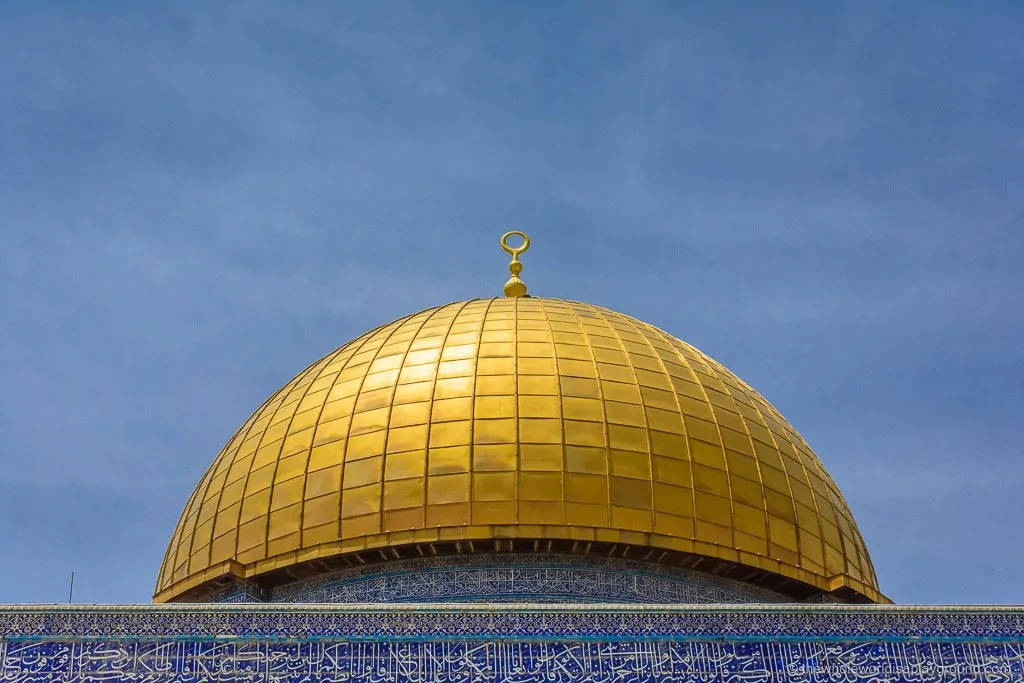
Temple Mount is one of the one most incredible sights in Jerusalem but restricted opening hours and tight security can make it difficult to visit. With some careful planning we were able to access the site of Temple Mount and it was one of the highlights of our trip to Israel. Here’s our step by step guide to visiting Temple Mount as a tourist or Non-Muslim.
1 | The Entrance to Temple Mount
Temple Mount can be accessed by 11 gates in the Old City of Jerusalem but tourists and non-Muslims are only allowed to enter through the Moroccan Gate which is also known as Mugrabi Gate. This gate is located near the Western Wall Plaza close to Dung gate.
The wooden walkway marking the non-Muslim entrance to Temple Mount:
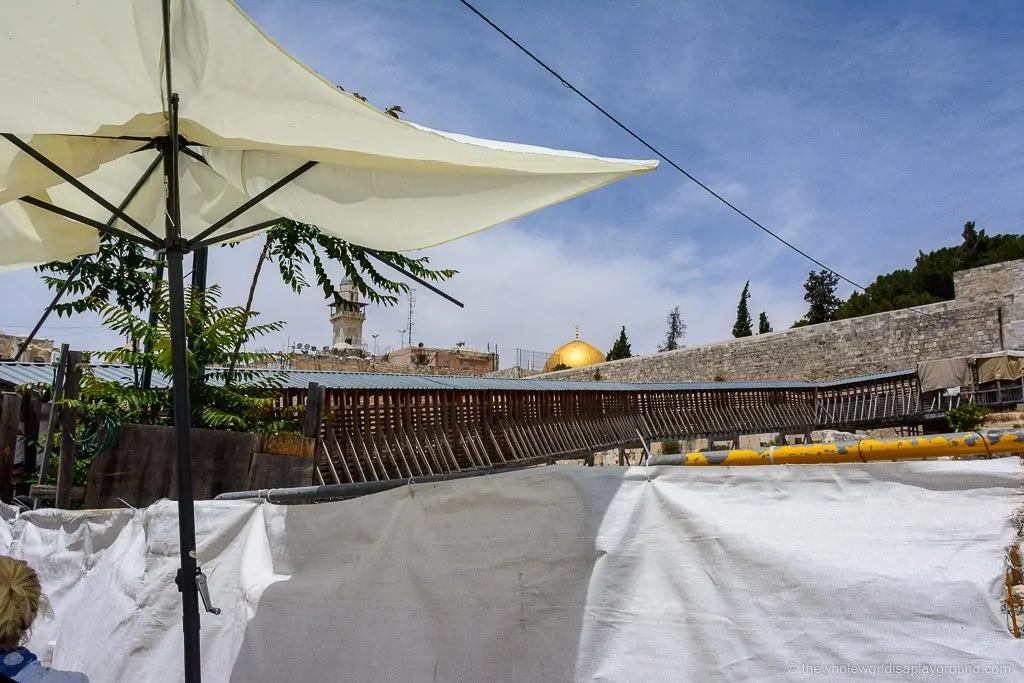
2 | Tourist and Non-Muslim Opening Times at Temple Mount
Entrance times are restricted for tourists and non-Muslims and Temple Mount is only accessible during the below hours.
- Summer: Sunday to Thursday: 8:30am to 11:30am and 1:30pm to 2:30pm
- Winter: Sunday to Thursday: 7:30am to 10:30am and 12:30pm to 1:30pm
- If you don’t make it through security before closing the guards won’t let you in.
It is possible that the site may be closed for security reasons at any time and, as a result, entrance is not guaranteed. Temple Mount is typically closed to non-Muslims on Jewish festivals and Israeli national days when rioting is likely to occur. Due to this try to plan your visit early in your trip to Jerusalem in case of closures.
The discarded riot shields act as a reminder of the unrest that had broken out at Temple Mount and resulted in its closure the day prior to our visit:
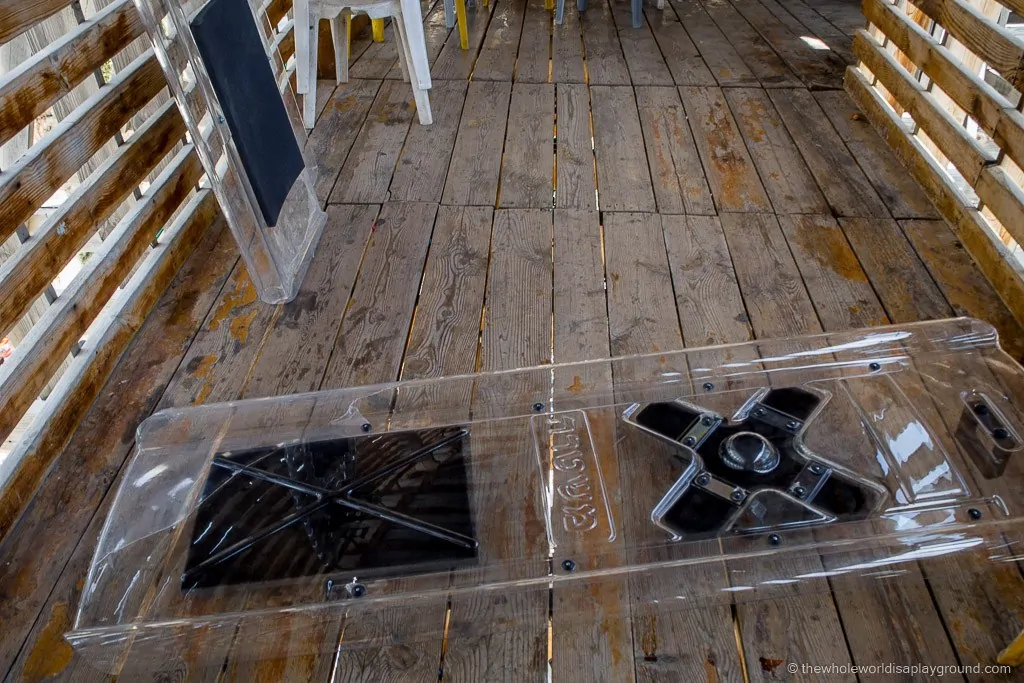
Where to stay in Jerusalem
Visiting Jerusalem is an incredible experience but due to the layout of the city and the narrow streets the only real way to explore the city is to walk. We found visiting the Old City early in the morning and later in the evening when crowds were quieter to be the best experience. To allow you to do this we recommend staying as close to the Old City walls as possible. The best hotels we recommend are:
- Harmony Hotel: Where we stayed and a short 5 minute walk from the Jaffa Gate entrance to the Old City. This stunning boutique hotel really made our stay in Jerusalem special. A delicious breakfast each morning, afternoon drinks on the sun filled terrace and a perfect location make this our top pick for staying beside the Old City of Jerusalem. The local area is lively with a great atmosphere and lots of great restaurants and bars. The hotel also has free parking which was great when we rented a car for a day trip to Massada – click here to book now!
- Sephardic House Hotel : located within the Old City itself in the Jewish Quarter (close to the Zion Gate), this hotel is a short walking distance from all of the sights, Church of the Holy Sepulchre, Temple Mount and the Western Wall to name a few nearby). Perfect if you want to stay in the Old City itself – click here to book now!
- Bezalel Hotel: A fantastic value hotel located 10 minutes walk from the Jaffa Gate. A sister hotel of the Harmony hotel, the Bezalel is a great alternative if the Harmony Hotel is booked out! – click here to book now!
Click here for the best Jerusalem hotel prices
3 | The Queues
Having made a failed attempt to visit Temple Mount earlier in the week, we weren’t taking any chances on missing out and we arrived around 12pm for the 1:30pm summer afternoon visiting session! We were first in the line but by the time Temple Mount opened for visitors there was an enormous queue behind us. Bring water, sunscreen and a hat as there’s little shade and the slow security checks mean it can take over an hour to pass through.
Watching a Bar Mitzvah pass by on the way to the Wailing Wall:
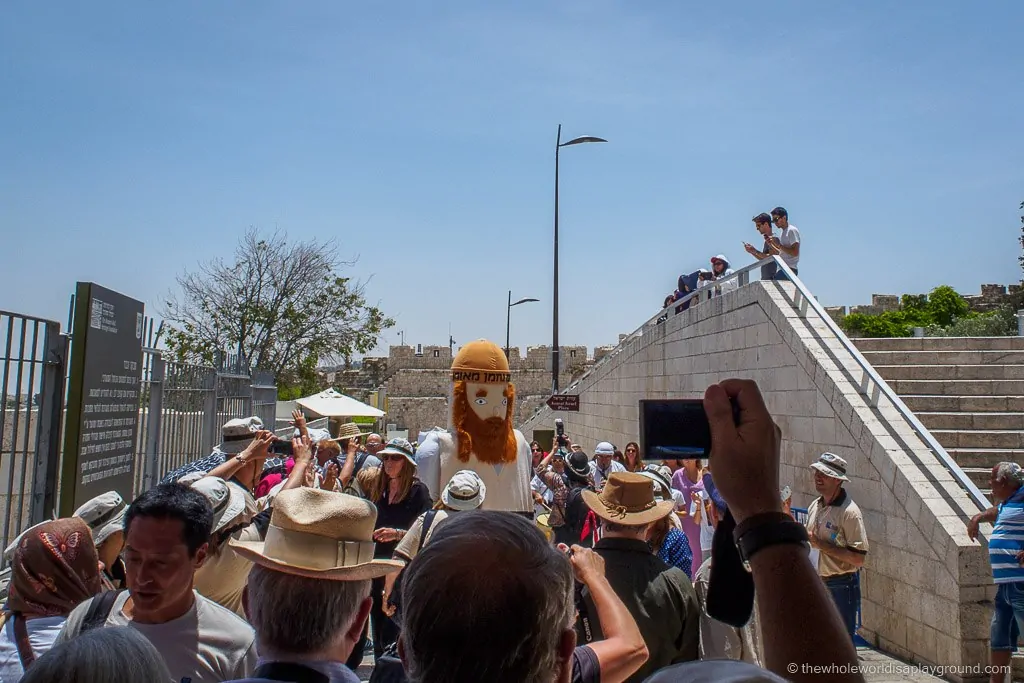
3 | Temple Mount Dress Code
A modest dress is essential to gain access to Temple Mount. Women should wear a knee length dress or trousers (trousers are preferable as some cotton skirts can be considered as see through and therefore inappropriate) and upper arms and chest must be covered by a top or a scarf. Men are required to wear long pants below the knee or cover up with a shawl.
I like your skirt!
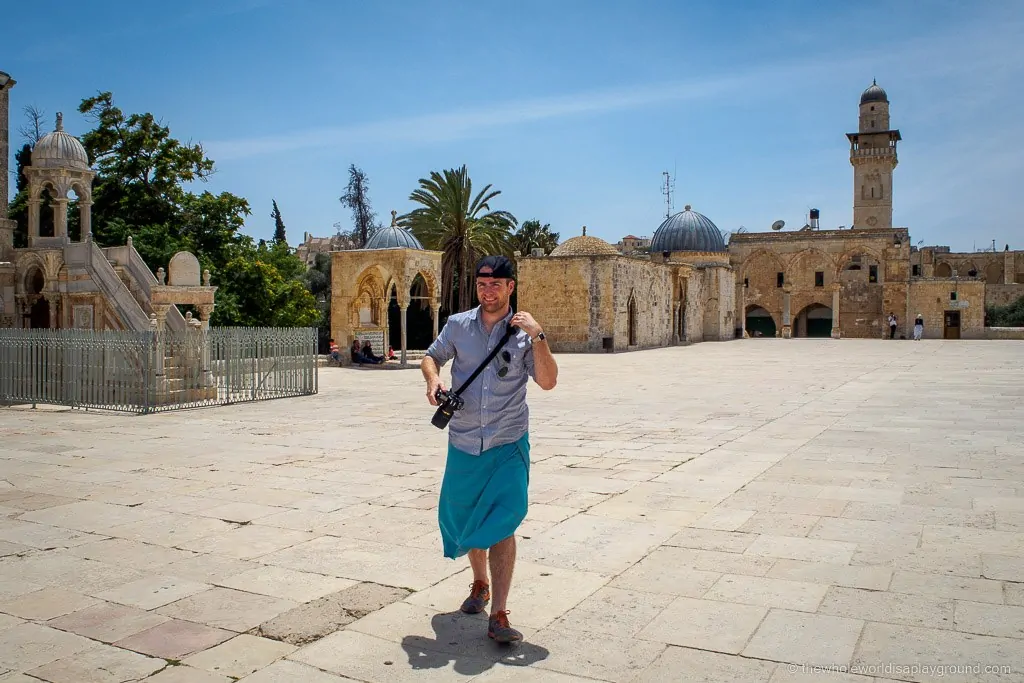
4 | Security Checks
Bring your passport and ensure that you are not carrying anything that could be considered as a weapon. Security is tight at Temple Mount with airport style checks at the entrance and our passports were checked upon entry. It is not permissible to bring sacred Jewish objects to the Temple.
The security hut:
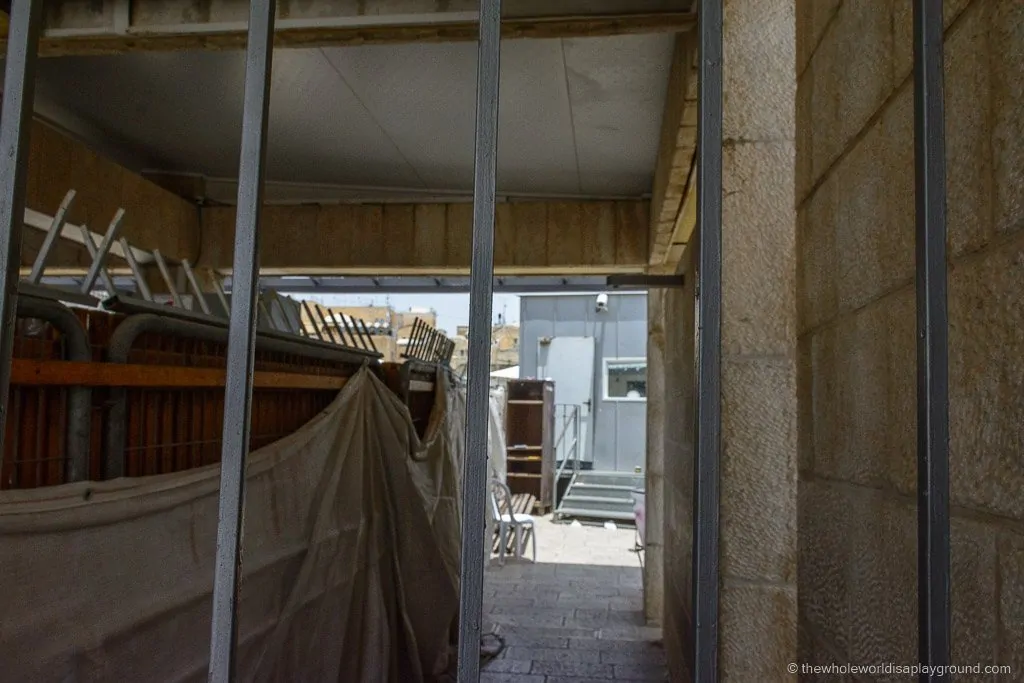
Having had our passports scrutinized and passing the clothing and security checks we were finally granted access to Temple Mount. For more pictures and info on our visit check out our post here.
We made it! The wooden walkway marking the entry way to Temple Mount:
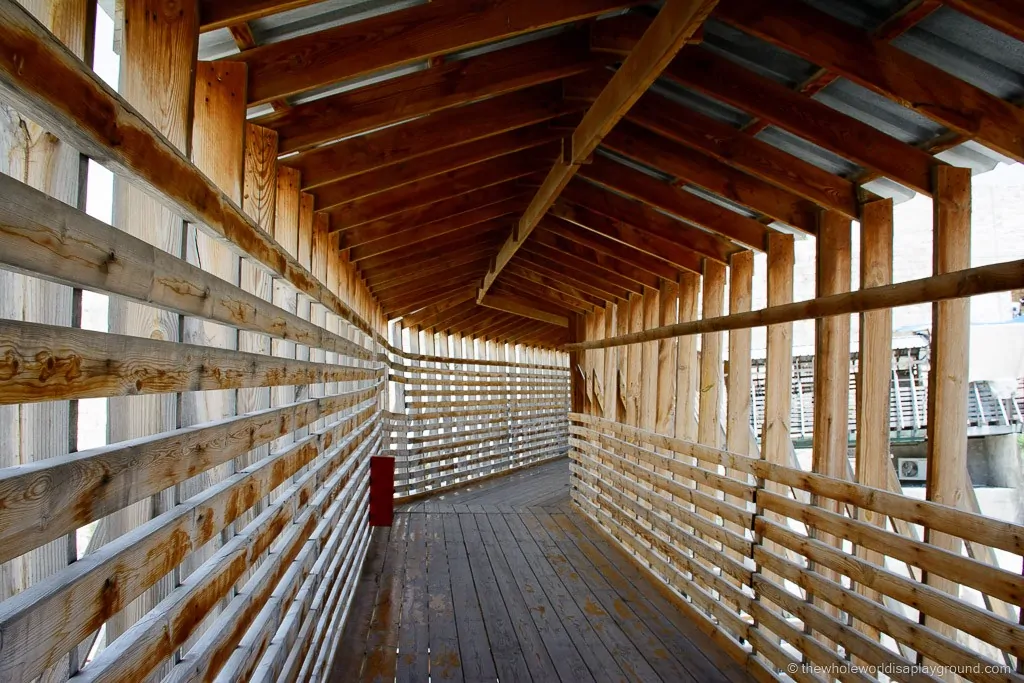
5 | While Visiting Temple Mount
First and foremost Temple Mount is a religious site and must be treated as such. Be respectful.
The Israeli government currently enforces a ban on non-Muslim prayer on the site and anyone who does not obey this ban may be removed from the site.
Entering the Mosques
Non-Muslims are forbidden from entering Dome of the Rock or Al-Aqsa mosque.
Entrance sign:
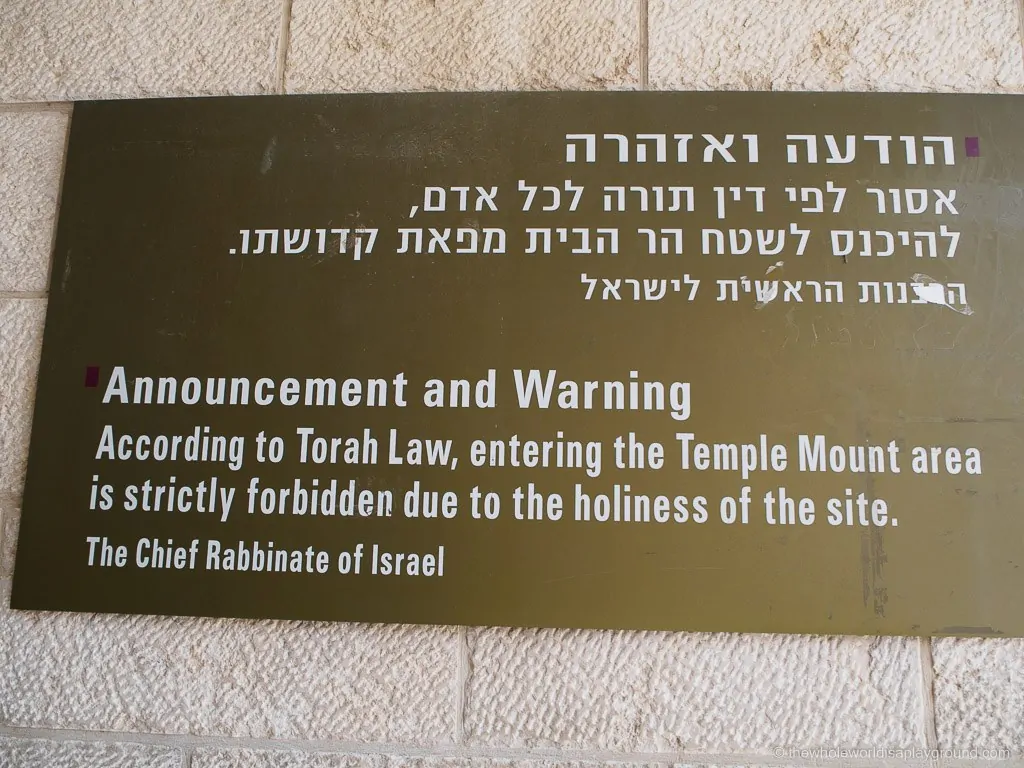
Is it safe to visit Temple Mount?
The high levels of security meant we felt very safe during our visit to Temple Mount. The authorities are quick to react during times of unrest and typically close the site on Jewish festivals and Israeli national days when rioting is a possibility.
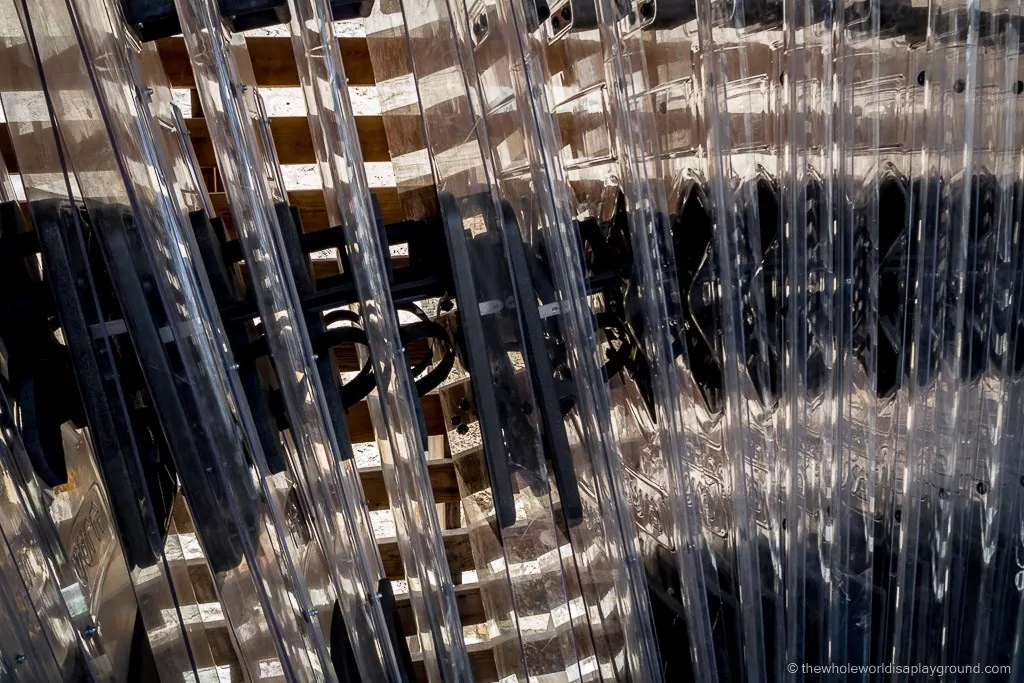
For more on our visit to Temple Mount check out our incredible pics and details of the trip here!
21 thoughts on “how to visit temple mount as a tourist: old city, jerusalem, israel”.
Very informative
Thank you so much for this blog! I have been doing research on non-muslims visiting this area, and it is very hard to find information. Can you tell me about the safety of the area? Where did you guys lodge? Thanks!
Hi Kenna! We found Jerusalem very safe and there was a lot of security which put us at ease. We stayed in a little boutique hotel not far from the Old City called Harmony Hotel, we really liked it. Hope that helps!
Thanks for the great info. I think we will try to go up there on a Thursday afternoon 1st October, during Sukkot, a Jewish festival. This will be our only chance. Do you think it will be open on that kind of holiday day? Also, would you know if 1st October is considered summer or winter time? Don’t want to get the wrong hour. Thanks kindly.
Hi Judith. I believe it was open last year but it could be very busy and tensions have been very high in previous years (have a look at some of the news articles from 2014). I think October would fall under winter but the hours could vary during the festival.
Very nice blog! Thank you very much for important details. Regards from Salzburg!
Thanks Alexander, glad you found the post useful!
Really helpful post! I’m going to try and get there tomorrow! Thanks for posting!
Glad it was useful Ellie, saw your pic on Instagram so know you made it!
Hello, in regards to not being able to enter the Dome or Mosque as a non-muslim. How did they know/check if you where one?
Hi Andres! I guess they can gather a lot from appearance – we looked like complete tourists so it was very obvious! We approached one of the entrances earlier in the week and were meet with a lot of shouting and waving.
Great post, Elaine! Very informative and useful!
Thanks Cameron, glad you liked it!
Thanks for this, Elaine! What months are considered “winter”? We’re planning to go in two weeks– in March. Thanks!
Hi Wayne, glad you liked the post! I’m guessing March is winter but not really sure! Let me know when you visit if you find out!
Extremely helpful – thank you so much for the details and pictures you’ve included here
You fail to point out that Non Muslims are treated differently to Jews especially religious Jews. Non Jews have quicker, access through security checks to the Mount . Also they are able to walk around freely without Police escort to most areas . Jews on the other hand are allowed only to walk where Police and Wakf ( Jordanian Security) allow and must follow Police instructions at all time.Saying a prayer out loud can and does get you thrown off . You are also not allowed to drink from water taps. This is the only site in all of Israel where there is NO freedom of religion. However don’t let this stop you . Go .. the more people that go up to the Mount the better . I go once a week.
Thanks for the info
Hello, I am writing fiction. Assuming VERY unusual circumstances, such as an emergency and government approval, can vehicles access the Mount or is that physically impossible?
I have no idea! Good luck with your research!
Were you able to go inside the mosque? I went in there back in 1976 and again in 1983.
Leave a Comment Cancel reply
Save my name, email, and website in this browser for the next time I comment.
Disclaimer: As an Amazon Associate I earn from qualifying purchases.

Dome of the Rock and The Temple Mount – Travel Guide
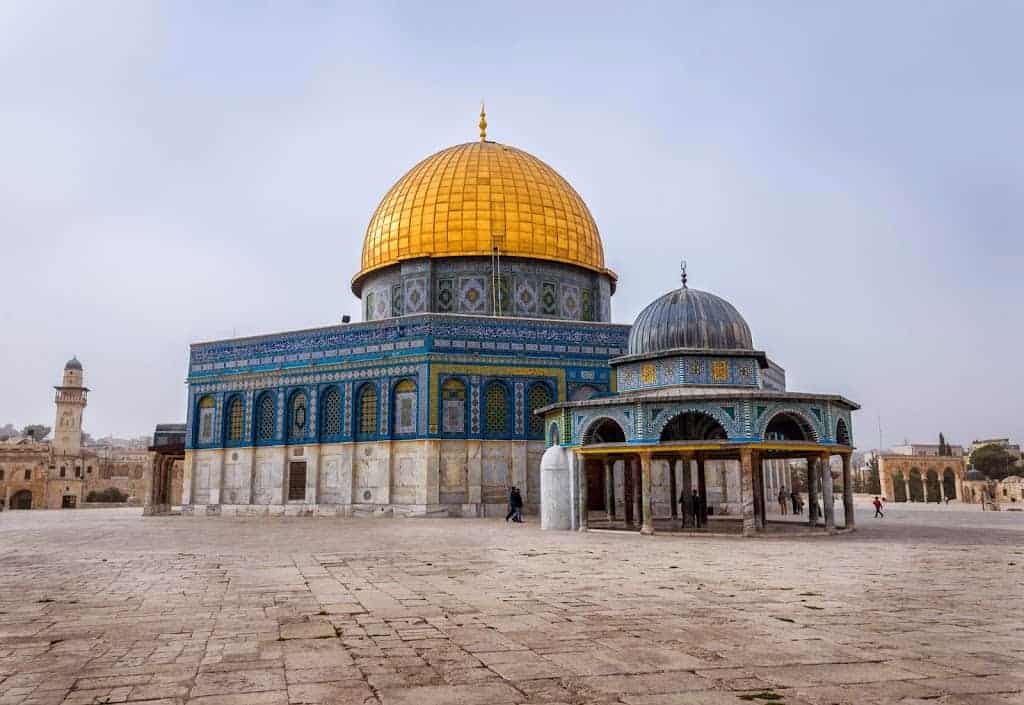
Before visiting the Dome of the Rock and The Temple Mount in Jerusalem, this guide will cover everything you need to know.
Table of Contents
- 2 Directions
- 3 Temple Mount Entrances
- 4 Opening Hours
- 5 Entrance Fee
- 6 Security Check
- 7 Dress Code
- 8 Short Overview
- 9.1 Temple Mount – Description
- 10.1 Al-Aqsa Mosque – Description
- 11.1 Dome of the Rock – Description
- 11.2 Inside Dome of the Rock
- 12 The Temple Mount and Archaeology
- 13 Common Questions
Dome Of The Rock and Al-Aqsa Mosque are situated on the Temple Mount within the Old City Of Jerusalem . Dung Gate is the closest one, but you can reach it from any entrance.
Directions for drivers: Link to Waze and Link to Google Maps Directions for public transport: Link to Moovit
Interactive map of the area:
- Hotels, hostels, and apartments in this area:
- Buy photos of Israel and support this blog.
- Get 10% off for your next tour at Bein Harim with coupon code LEV10#12306.
You can find the following map in several places in the Old City of Jerusalem .
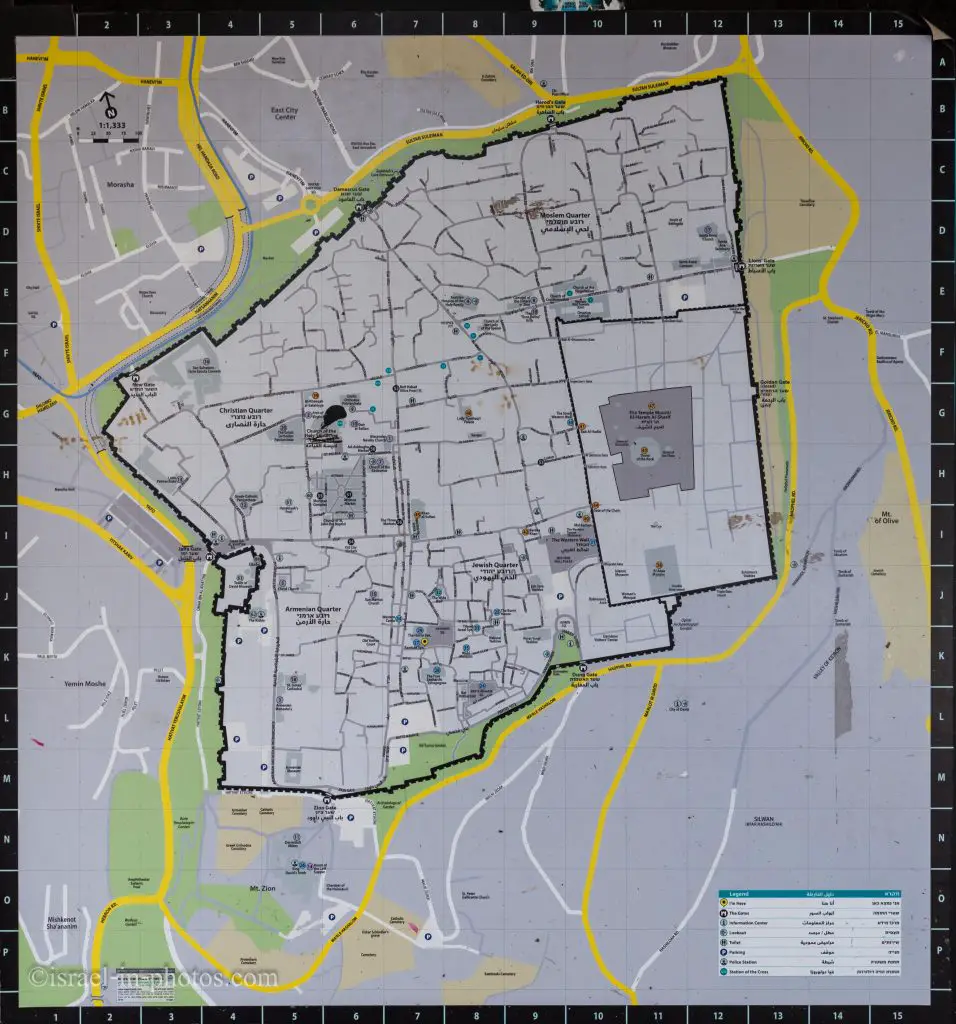
Note: you can click on the map to enlarge it.
On the photo of the map above, the Dome Of The Rock is marked as #43 (square H11). Al-Aqsa Mosque is listed as #38 (square J11), and the Temple Mount is marked as #47 (square G11).
To complete this section, I would like to show an aerial photo. However, as far as I know, you cannot fly drones above the Old City. But you can always take a picture of a model. Here is a photo of the Western Wall and Temple Mount (a model at Mini Israel ).
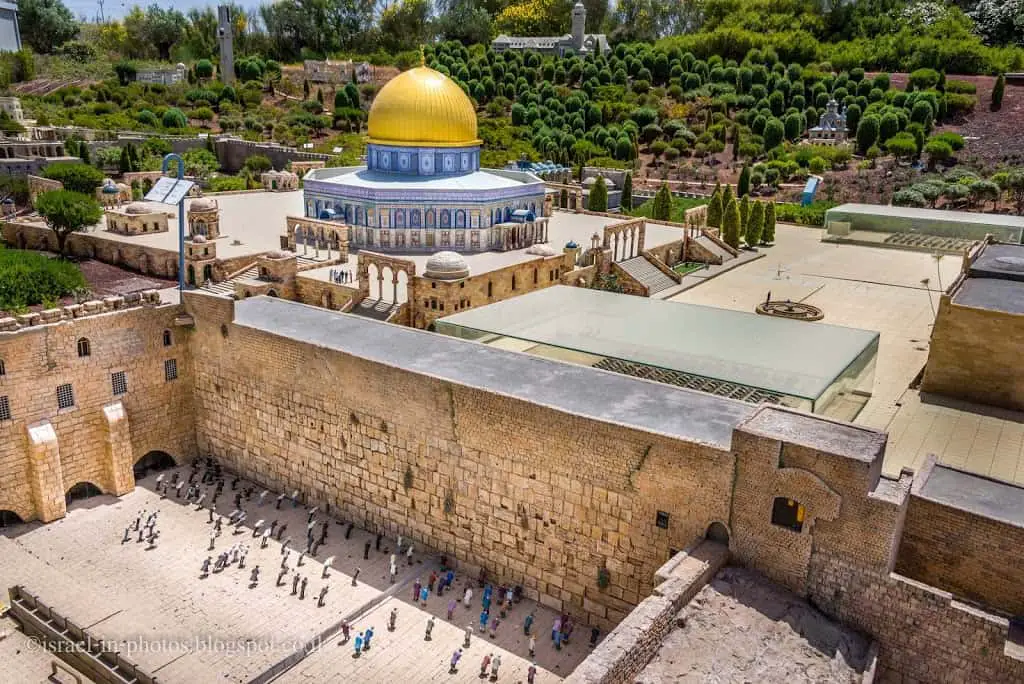
See the Old City Of Jerusalem for detailed directions on reaching this site.
Temple Mount Entrances
There are eleven entries to the Temple Mount. Muslim prayers can enter through ten of them. But non-Muslims are not allowed to pass there. And for visitors, there is an additional entrance near the Western Wall .
For a more straightforward explanation, let’s use the following aerial photo from Davidson Center .
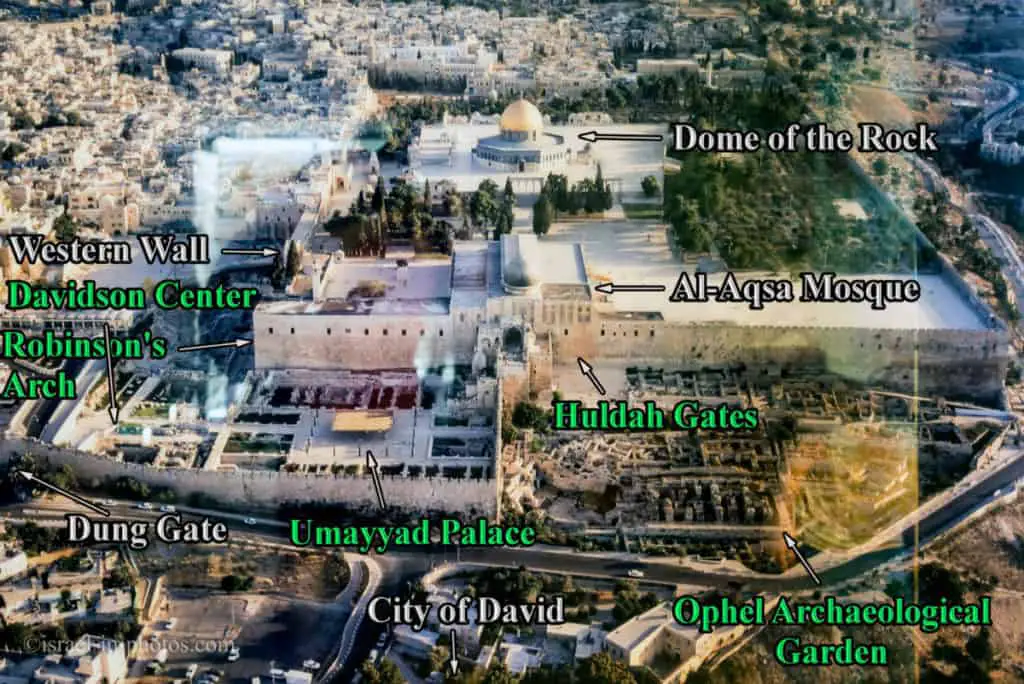
The simplest way to reach the tourist entrance is by entering the Old City through the Dung Gate (lower-left corner in the photo above). Then you continue straight along the fence of Davidson Center until you reach the security checkpoint. There are three entrances at this security point. Two lead to the Western Wall , and the one to the right climbs up to the Temple Mount.
In the following photo of the Western Wall, you can see a bridge to the right. You will be using it to climb the Temple Mount.

Opening Hours
Summer: Sundays – Thursdays: 7:30 – 11:00, 13:30 – 14:30. Winter: Sundays – Thursdays: 7:00 – 10:30, 12:30 – 13:30.
The Temple Mount is closed to tourists on Fridays and Saturdays .
- The opening hours can change due to security limitations. In Jerusalem, you can see the opening on a small electronic display above the entrance. Or you can call +972-2-6226250 in advance and find out about changes.
- The opening hours are pretty limited, and there is a security check at the entrance (you may find yourself waiting in a long line). Thus, I suggest arriving early.
Entrance Fee
Security check.
The security check is similar to the one you pass in an airport. Before entering, you will pass metal detectors, and your bags will be scanned. Also, the security personnel may request an id. Thus make sure you have your passport with you.
Also, I want to mention that you are not allowed to bring any religious artifacts to the Temple Mount.
The last thing you need to know before visiting is the dress code rules. As with other holy sites, visitors to the Temple Mount are asked to dress modestly. I call it the “knees and shoulders” rule – meaning at least a knee-length dress or trousers. And the shoulders should be covered by a top or a scarf.
Short Overview
The Temple Mount – in Arabic, al-Haram al-Sharif – dominates the Jerusalem skyline. With the Dome of the Rock and the Al-Aqsa Mosque at its center, this rectangular esplanade of some 150,000 square meters occupies one-sixth of the terrain in the Old City. For at least 3000 years, this site has been considered sacred for millions of people worldwide, first by the Jews, later by the Muslims, and Christians also revere it. It inspires research in history, archeology, and culture and incites controversial religious and political sentiments. In Hebrew, it is known as Mount Moriah and Har ha-Bayit (the Temple Mount). In Jewish tradition, it is where Isaac was bound and where Solomon built the First Temple. After its destruction, the Second Temple was built on this same spot by the Jews who returned from exile, and the Hasmoneans and King Herod later renewed this Temple. Following the destruction in 70 CB, it became the focus of Jewish prayer and longing for reconstruction at the final redemption. The Prophet Muhammad established Jerusalem as the first direction of Muslim prayer before the Kaaba in Mecca, and the al-Aqsa Mosque is referred to as “the first Qibla” or “the first direction” of prayer. Muslim tradition also maintains that this mosque was the second place of Islamic worship. The Quran mentions the “farthest mosque: to which Muhammad traveled from Mecca to ascend to heaven on his celestial horse. Muslim tradition regards Al Aqsa as this “farthest mosque.” The site is considered the third holiest in Islam, after the Kaaba in Mecca and The Prophet’s Mosque in Medina. Since its construction, it has been an essential Muslim center, except for a short period under the Crusaders (1099-1187). In Arabic, it is known as al-Haram al-Sharif (“the Noble Sanctuary”) or al-Aqsa, a general name for the plaza. Both Jews and Muslims believe that the Foundation Stone at the center of the Mount is the umbilicus Mundi, the navel of the world, on which the earth rests and from which it expanded. In Christian tradition, the site has historical significance as the site of many events in the life of Jesus of Nazareth and the place where he founded his new religion.
Source: “The Mount” exhibition at the Tower Of David .
On The Temple Mount
Now, after covering the basics, let’s visit Temple Mount. Also, in this section, I want to bring informational extracts.
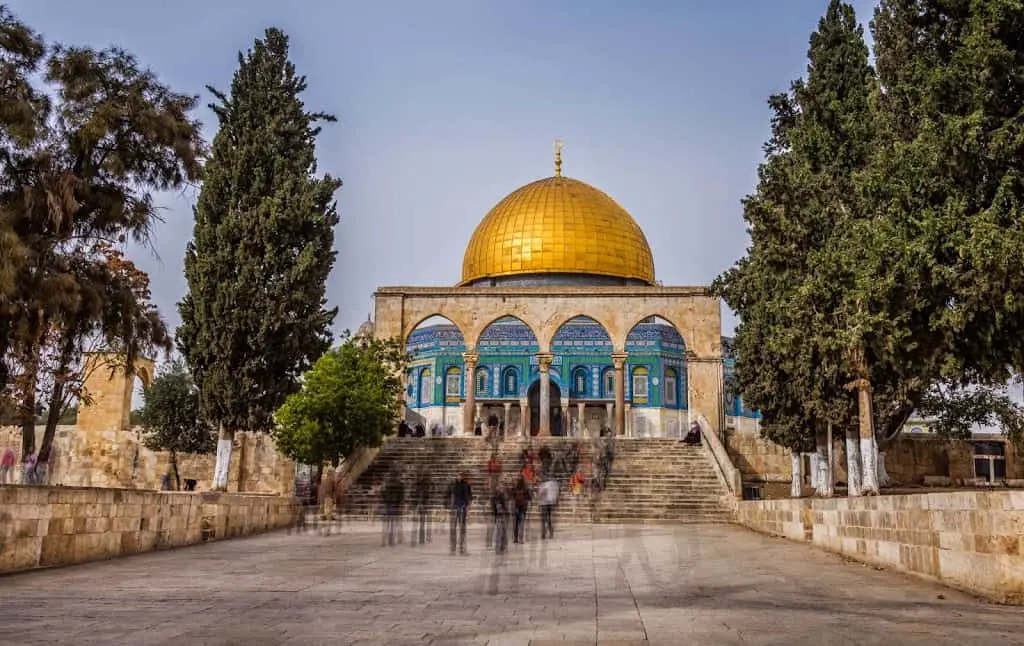
Temple Mount – Description
The Temple Mount (Hebrew: Har HaBáyit, “Mount of the House [of God, i.e., the Temple in Jerusalem]”), known to Muslims as the Haram esh-Sharif (Arabic: al-Ḥaram al-Šarīf, “the Noble Sanctuary”, or al-Ḥaram al-Qudsī al-Šarīf, “the Noble Sanctuary of Jerusalem”) and the Al Aqsa Compound, is a hill located in the Old City of Jerusalem that for thousands of years has been venerated as a holy site in Judaism, Christianity, and Islam alike. The present site is a flat plaza surrounded by retaining walls (including the Western Wall), which was built during the reign of Herod the Great for an expansion of the Temple. The plaza is dominated by three monumental structures from the early Umayyad period: the al-Aqsa Mosque, the Dome of the Rock, and the Dome of the Chain, as well as four minarets. Herodian walls and gates, with additions from the late Byzantine and early Islamic periods, cut through the flanks of the Mount. Currently, it can be reached through eleven gates, ten reserved for Muslims. One for non-Muslims, with guard posts of Israeli police in the vicinity of each. According to Jewish tradition and scripture, the First Temple was built by King Solomon, the son of King David, in 957 BCE, and destroyed by the Neo-Babylonian Empire in 586 BCE. However, no substantial archaeological evidence has verified this. The Second Temple was constructed under the auspices of Zerubbabel in 516 BCE and destroyed by the Roman Empire in 70 CE. Jewish tradition maintains that a third and final Temple will also be built here. The location is the holiest site in Judaism and is the place Jews turn towards during prayer. Due to its extreme sanctity, many Jews will not walk on the Mount itself to avoid unintentionally entering the area where the Holy of Holies stood since, according to Rabbinical law, some aspect of the divine presence is still present at the site. Among Muslims, the Mount is the site of one of the three Sacred Mosques, the holiest sites in Islam. Amongst Sunni Muslims, it is considered the third holiest site in Islam. Revered as the Noble Sanctuary, the location of Muhammad’s journey to Jerusalem and ascent to heaven, the site is also associated with Jewish biblical prophets who are also venerated in Islam. Umayyad Caliphs commissioned the construction of the al-Aqsa Mosque and Dome of the Rock on the site. The Dome was completed in 692 CE, making it one of the oldest existing Islamic structures in the world. The Al Aqsa Mosque rests on the far southern side of the Mount, facing Mecca. The Dome of the Rock currently sits in the middle, occupying or close to the area where the Holy Temple previously stood. In light of the dual claims of both Judaism and Islam, it is one of the most contested religious sites in the world. Since the Crusades, the Muslim community of Jerusalem has managed the site as a Waqf. The Temple Mount is within the Old City, which Israel has controlled since 1967. After the Six-Day War, Israel handed administration of the site back to the Waqf under Jordanian custodianship while maintaining Israeli security control. It remains a major focal point of the Arab–Israeli conflict. In an attempt to keep the status quo, the Israeli government enforces a controversial ban on prayer by non-Muslims.
Source: Wikipedia
Panorama of the Second Temple Model at Israel Museum :

Herodian Temple Mount and the modern one (shot during Archeological Experience at Tzurim Valley National Park ):
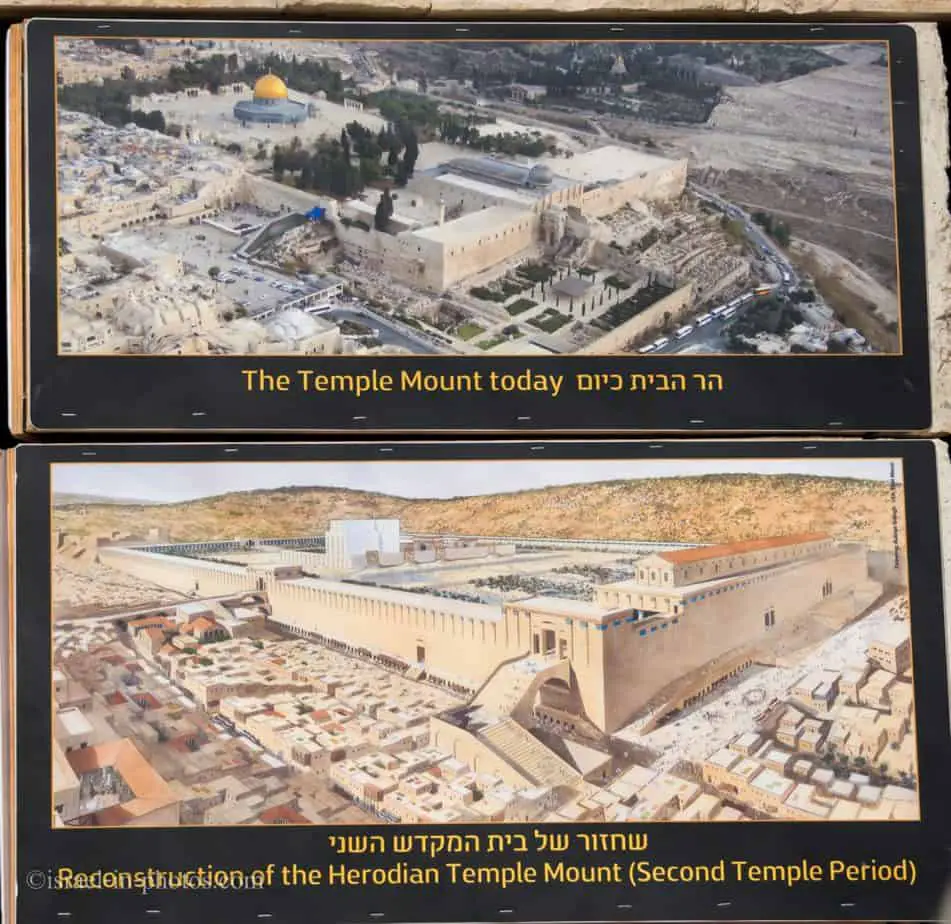
Al-Aqsa Mosque
You enter the Temple Mount in its southern part, near the al-Aqsa Mosque.
The opening hours were adjusted to prayer times. And you will be visiting in between prayers. Nonetheless, during my visit, I saw some people resting and others praying in front of the Al-Aqsa Mosque. I did not feel comfortable photographing them, so here is a photo of the Al-Aqsa Mosque from the Davidson Center .
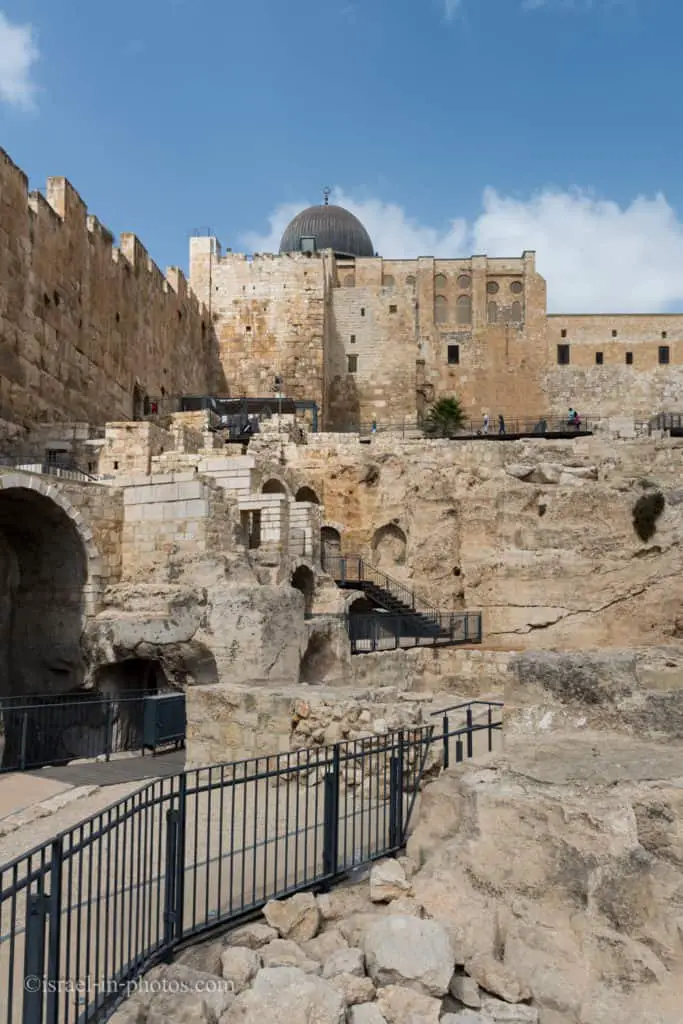
Al-Aqsa Mosque – Description
The Al-Aqsa Mosque (“the Farthest Mosque”), located in the Old City of Jerusalem, is the third holiest site in Islam. The mosque was built on top of the Temple Mount, known as the Al Aqsa Compound or Haram esh-Sharif in Islam. Muslims believe Muhammad was transported from the Great Mosque of Mecca to al-Aqsa during the Night Journey. Islamic tradition holds that Muhammad led prayers towards this site until the 17th month after he migrated from Mecca to Medina, when Allah directed him to turn towards the Kaaba in Mecca. The covered mosque was originally a small prayer house erected by Umar, the second caliph of the Rashidun Caliphate, but was rebuilt and expanded by the Umayyad caliph Abd al-Malik and finished by his son al-Walid in 705 CE. The mosque was destroyed by an earthquake in 746 and rebuilt by the Abbasid caliph al-Mansur in 754. It was rebuilt again in 780. Another earthquake destroyed most of al-Aqsa in 1033, but two years later, the Fatimid caliph Ali az-Zahir built another mosque whose outline is preserved in the current structure. The mosaics on the arch at the qibla end of the nave also go back to his time. During the periodic renovations undertaken, the various ruling dynasties of the Islamic Caliphate constructed additions to the mosque and its precincts, such as its Dome, facade, its minbar, minarets, and the interior structure. When the Crusaders captured Jerusalem in 1099, they used the mosque as a palace and the Dome of the Rock as a church, but its function as a mosque was restored after its recapture by Saladin in 1187. The Ayyubids, Mamluks, Ottomans, the Supreme Muslim Council, and Jordan undertook more renovations, repairs, and additions in the later centuries. Today, the Old City is under Israeli control, but the mosque remains under the administration of the Jordanian/Palestinian-led Islamic Waqf.
Dome of the Rock
I headed towards the Dome of the Rock from the Al-Aqsa Mosque. And here is the al-Kas ablution fountain.
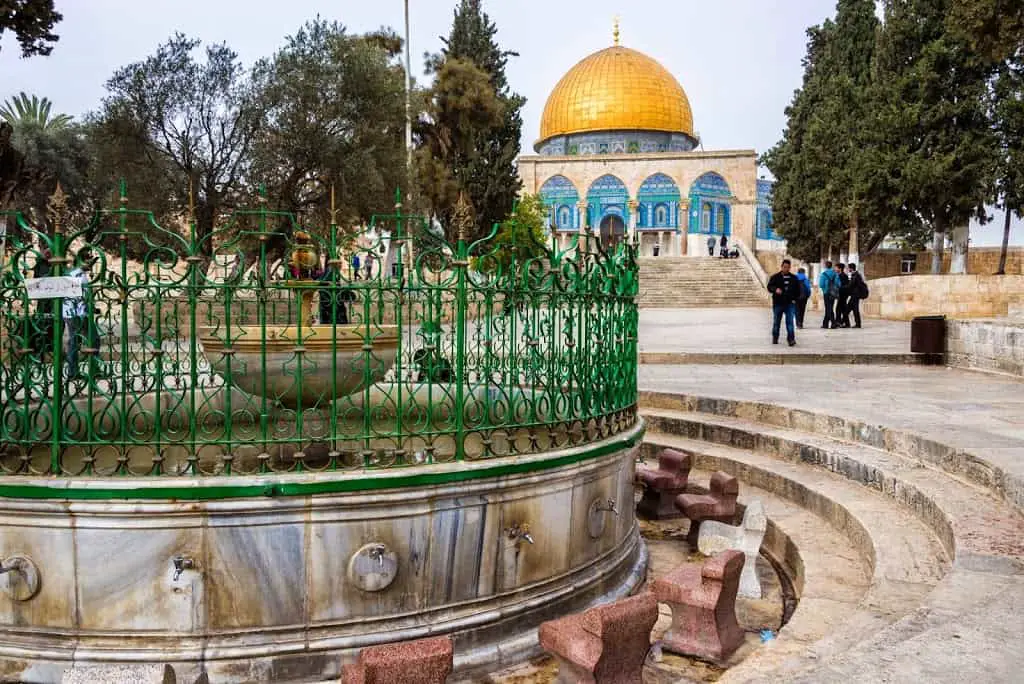
Dome of the Rock – Description
The Dome of the Rock is an Islamic shrine located on the Temple Mount in the Old City of Jerusalem. It was initially completed in 691–92 CE at the order of Umayyad Caliph Abd al-Malik during the Second Fitna on the site of the Second Jewish Temple, destroyed during the Roman Siege of Jerusalem in 70 CE. The original Dome collapsed in 1015 and was rebuilt in 1022–23. At its core, the Dome of the Rock is one of the oldest existing works of Islamic architecture. Its architecture and mosaics were patterned after nearby Byzantine churches and palaces. However, its outside appearance was significantly changed in the Ottoman period and again in the modern period, notably with the addition of the gold-plated roof, in 1959–61 and again in 1993. The octagonal plan of the structure may have been influenced by the Byzantine Church of the Seat of Mary (also known as Kathisma in Greek and al-Qadismu in Arabic), built between 451 and 458 on the road between Jerusalem and Bethlehem. The Foundation Stone the Temple was built over bears great significance in the Abrahamic religions as the place where God created the world and the first human, Adam. It is also believed to be where Abraham attempted to sacrifice his son and as the place where God’s divine presence is manifested more than in any other place, towards which Jews turn during prayer. The site’s great significance for Muslims derives from traditions connecting it to the creation of the world and the belief that Muhammad’s Night Journey to heaven started from the rock at the center of the structure. A UNESCO World Heritage Site, it has been called “Jerusalem’s most recognizable landmark,” along with two nearby Old City structures, the Western Wall and the “Resurrection Rotunda” in the Church of the Holy Sepulchre. It is the earliest archaeologically-attested religious structure built by a Muslim ruler, and the building’s inscriptions contain the earliest epigraphic proclamations of Islam and the Islamic prophet Muhammad. The inscriptions proved to be a milestone, as afterward, they became a common feature in Islamic structures and almost always mention Muhammad.
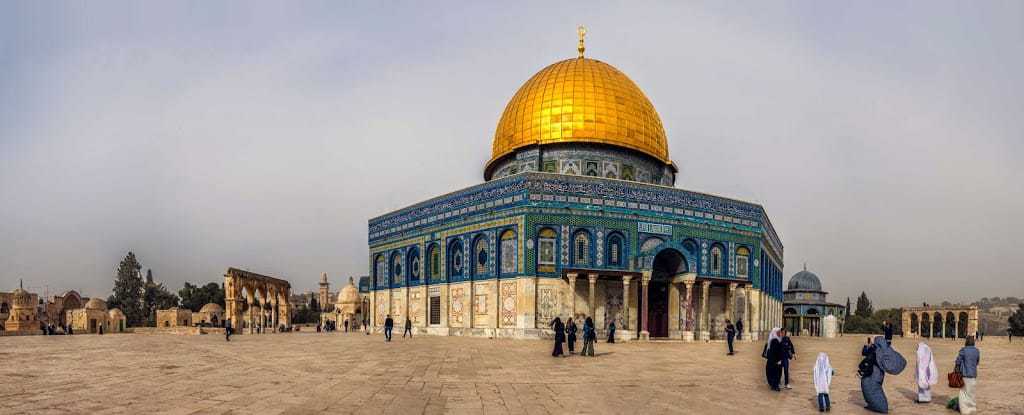
And here is a closeup:
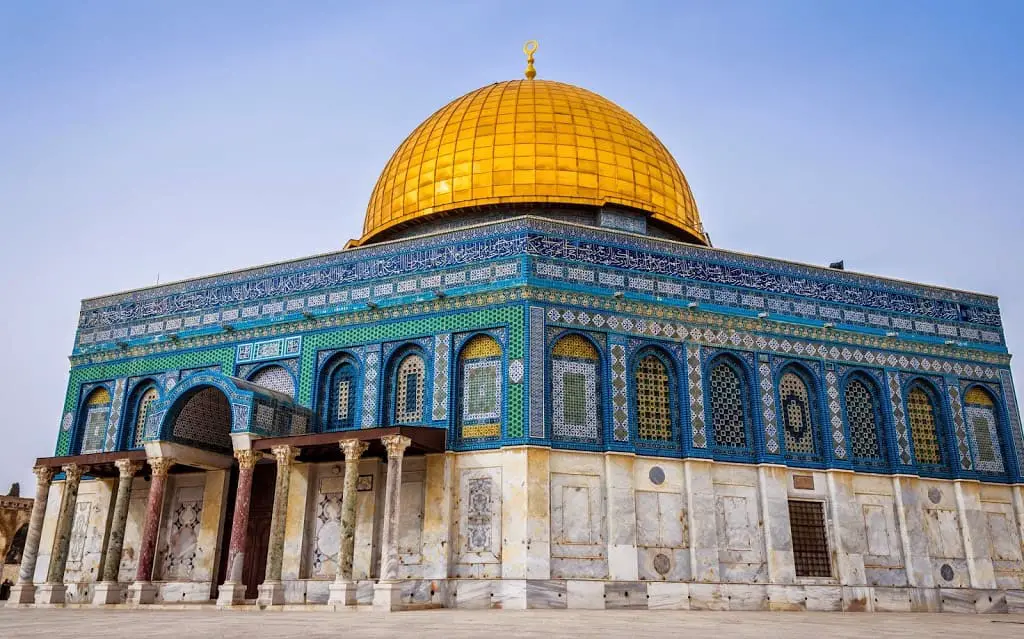
Inside Dome of the Rock
The Dome of the Rock exterior is stunning, but what about the interior? Well. Let’s start with another question.

Can you go inside the Dome of the Rock?
No. Non-Muslim visitors cannot enter the Dome of the Rock and the Al-Aqsa Mosque.
I have seen footage of non-Muslim visitors inside the Dome of the Rock. But for that, you need some connections in the Islamic Waqf. And I have none. Thus I was not inside. But I can show several photos of a model I photographed at the Tower Of David .
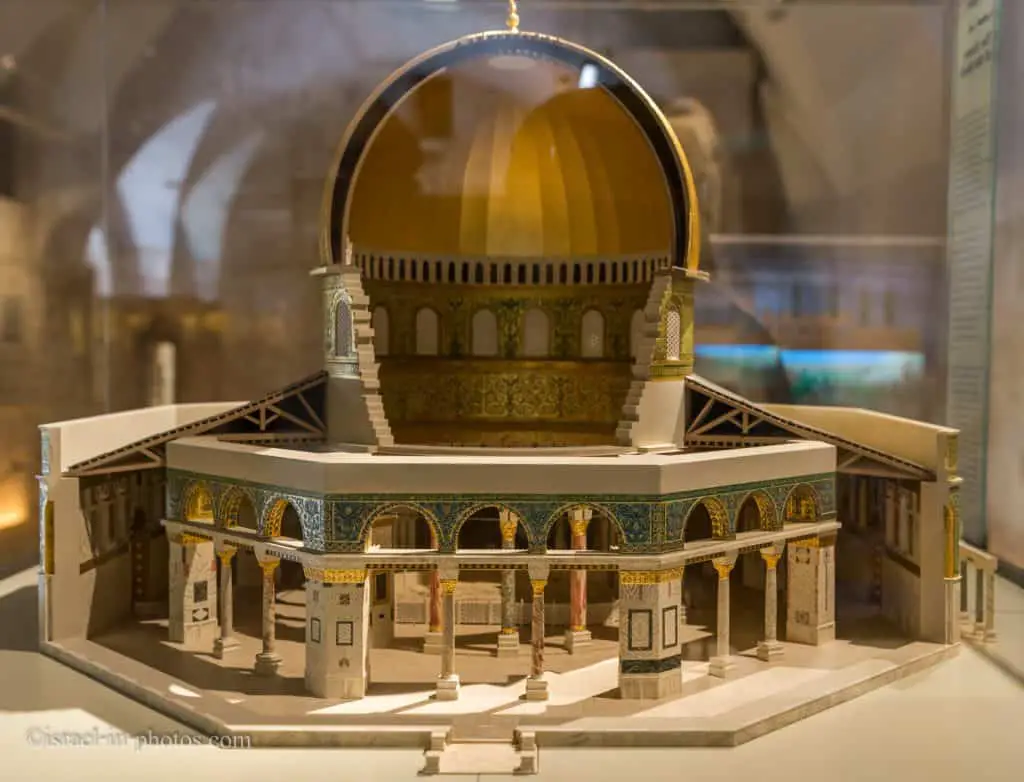
The interior of the Dome is lavishly decorated with mosaic, faience, and marble, much of which was added several centuries after its completion. It also contains Qur’anic inscriptions. The dedicatory inscription in the Kufic script placed around the Dome contains the date believed to be the year the Dome was first completed, AH 72 (691/2 CE). At the same time, the name of the corresponding caliph and builder of the Dome, al-Malik, was deleted and replaced by the name of Abbasid caliph Al-Ma’mun (r. 813–833), during whose reign renovations took place.

The Temple Mount and Archaeology
The Temple Mount is an important site, but it never underwent archaeological excavations.
In 1999, the Muslim Waqf began renewal work on the Temple Mount. The renovations were carried out without any archaeological supervision. The building contractors who worked on the Temple Mount dumped the earth and rubble they removed from the site at different trash dumping sites around the city.
As a result, it was decided to carry out extraordinary rescue excavations. And this is how the Temple Mount Sifting Project was born.

We visited Tzurim Valley National Park and participated in the Ancient Jerusalem Sifting Project. We enjoyed the experience, and I am mentioning it since it can be a lovely add-on to this visit.
Note: in the Ancient Jerusalem Sifting Project, we went through rubbles from the City Of David and not Temple Mount. You can find additional information at Tzurim Valley National Park .
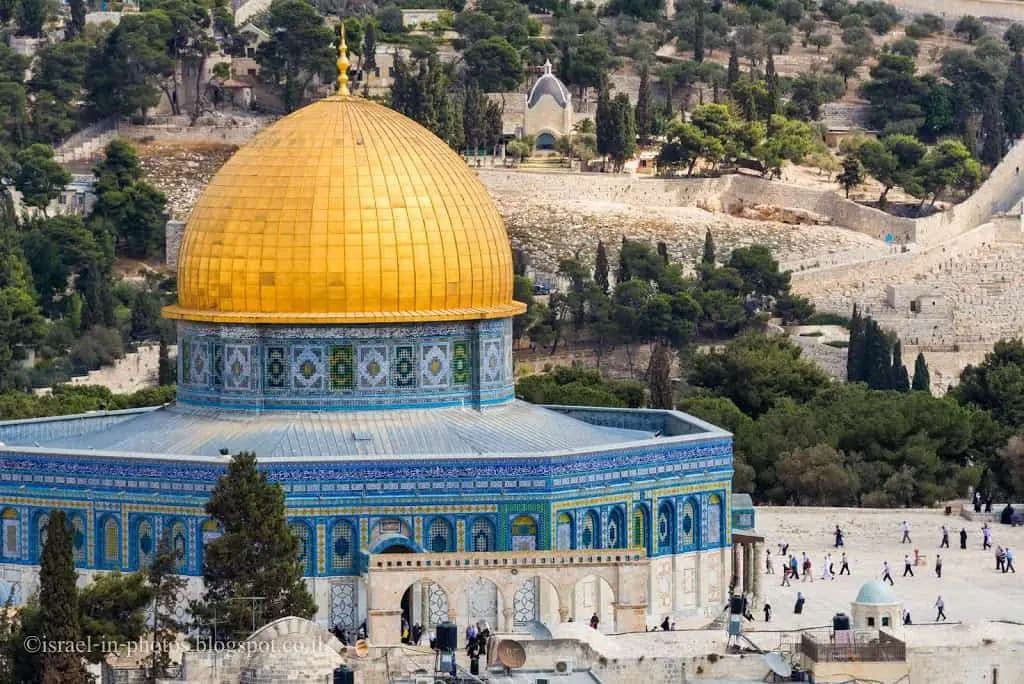
Common Questions
Inside the Dome of the Rock, you can find the Foundation Stone. And the Foundation Stone has tremendous significance in Abrahamic religions. For example, the belief that this is where God created the world and the first human.
Everybody can visit Temple Mount and see the Dome of the Rock exterior. But only Muslims are allowed to enter inside.
Everybody can visit the Temple Mount, but only Muslims can pray there.
Dome of the Rock is an Islamic shrine. You can find the Al-Aqsa Mosque nearby.
Visitors pass through the security checkpoint. Moreover, there are police patrols on the Temple Mount. Thus I felt perfectly safe. And in case of any unrest, the site will be closed to visitors.
As I mentioned in the guide to the Old City Of Jerusalem , the Dome of the Rock and the Temple Mount are among the most important sites in the city. Thus if you can, I would recommend not skipping it.
Have you ever visited the Dome Of The Rock And The Temple Mount? Tell us about your experience in the comments below.
That’s all for today, and I’ll see you in future travels!
Stay Tuned!
For additional points of interest nearby, check out Jerusalem and the Old City Of Jerusalem . And if you are looking for other places to visit, check out Around The Old City Of Jerusalem .
Additional Resources
- Israel Trip Planner is the page that will help you to create your perfect travel route.
- National Parks And Nature Reserves page lists and put all national parks on the map. There is also a top list, information about ticket types and campsites.
- If you are looking for things to do, here are the pages for Jerusalem , Tel Aviv , Haifa , Sea Of Galilee , and Makhtesh Ramon .
- Wondering what events are there in Israel? Here is the Events And Festivals By Season guide.
Lev Tsimbler
Lev from israel-in-photos.com. You can contact me at [email protected]
Leave a Reply Cancel reply
Your email address will not be published. Required fields are marked *
Save my name and email in this browser for the next time I comment.
Recent Posts
Gibton Springs Nature Reserve - Visitors Guide
Gibton Springs Nature Reserve near Mazkeret Batya offers an easy hike through water sources, a eucalyptus grove, and Tel Malut. Map Gibton Springs Nature Reserve near Mazkeret Batya (behind...
Rehovot Citrus Park - Visitors Guide
Rehovot Citrus Park has an ecological pond, playgrounds for children, picnic tables, and more. It is a good place for family time. Map Rehovot Citrus Park is behind Rehovot Cemetery - Yehuda...

- Bucket List
- Middle East
- Unique Experiences
How To Visit Jerusalem’s Temple Mount, Dome of the Rock, & Western Wall

Visiting the Temple Mount, including the Western Wall and Dome of the Rock, is a must on any trip to Jerusalem, and one of the things I looked forward to most on our trip.
However, you have to do some planning ahead of time—the lines can be long, security can be quite restrictive, and hours are limited. We were lucky the day we visited (a Wednesday in early May) and everything went very smoothly, but that was by no means a guarantee. At the bottom of this post I’ve outlined a ton of tips for planning your visit, so make sure you scroll all the way down!

Click here for our full 24-hour Jerusalem itinerary !
Three of the major world religions—Judaism, Christianity, and Islam—have been battling over this site for close to 2,000 years.
I’ve tried to provide a bit of background in this post to help understand logistics that affect your visit, but I strongly recommend you do your own deeper research before visiting because it’s a very complex and controversial history, and my intention here is not to educate you on all the different points of view or present one of my own.

Read next: Why a Sunrise Hike Up Masada Should Be On Your Bucket List
We were up early since we only had one full day in Jerusalem , and our friends’ friend Alejandro met us at our hostel and walked us toward the Old City. We’d decided to visit the Western Wall and Temple Mount first thing in the morning to beat the crowds and that was a great decision.
What is the Western Wall?
Also known as the Wailing Wall (though not by Jews) or Kotel, the Western Wall is a small section of a retaining wall of the Temple Mount, and formerly surrounded the Second Jewish Temple built by Herod the Great (which was destroyed by the Romans in 70 AD).
It’s one of the most holy and sacred sites to the Jewish faith, particularly since they don’t have control of the Temple Mount for worship.

You might also like: A Detailed Middle East Packing List: What to Bring & Wear
The wall is a UNESCO World Heritage Site dating from about the 2nd century BCE (though the upper parts were added a bit later) and runs along the western site of Temple Mount (the Muslim Quarter).
This site gives some good deeper background on why the Western Wall is sacred to the Jewish people, if you want to learn more about it.

You might also like: How to Plan an Epic 7-Day Israel & Jordan Itinerary
We walked up to security and only had to wait a second before getting through the metal detectors. After everything I’d read about long lines, it was a pleasant surprise.
One of the things the Western Wall is famous for is the written prayers that are tucked in all the cracks and crevices. If you wish, you can bring a prayer written on a piece of paper to tuck it inside the wall. A caretaker comes and collects them and they are buried on the Mount of Olives in an ancient ceremony. It’s a really lovely way to feel part of the history here.

You might also like: Is the Sunrise Masada, En Gedi, & Dead Sea Tour Worth It?
The Western Wall Plaza is divided by gender with a fence over 100 feet long, so if you’re visiting in a mixed group you’ll have to separate. However, there are gaps in the fence so you can see through the slats and take pictures of the men’s side (if you’re a woman).
It did feel weird taking pictures in an active religious site, and I’d caution you to just be respectful and discreet—this is a real, daily part of religious life for many Jews in Jerusalem.
If you’re a woman, bring a scarf as you will need to cover your shoulders and chest. If you don’t have one, they’ll provide one when you enter. Men need to have kippah (Jewish cap), and if you don’t have one (like my dad and Alejandro), they’re provided. I have a detailed Middle East travel packing list as well.
Fun facts: the Western Wall is actually just a retaining wall below the Temple Mount, and only about one-eighth of the original wall’s size!

Read next: A Sabbath Morning in Tel Aviv & Old Jaffa
Here you can see my dad and Alejandro with their borrowed kippah, and some of the pretty Torah that they provide for you to sit and study and reflect if you’d like.

From the Western Wall we headed to the Temple Mount, which is only a few steps away along a wooden pathway.
What is the Temple Mount?
The Temple Mount is the holiest site in Judaism, the third holiest site in Islam, and a revered site to Christians. Because of its importance to all three religions, ownership has been hotly contested for almost 2,000 years.
As I mentioned above, my goal with this post isn’t to get political (I have my own views, but that’s not what I’m here for), so rather than trying to summarize a very messy and complicated situation myself, I felt like this article pretty succinctly summarizes the key points, and it’s hard to go wrong (and easier to stay non-political) with the official Wikipedia article .
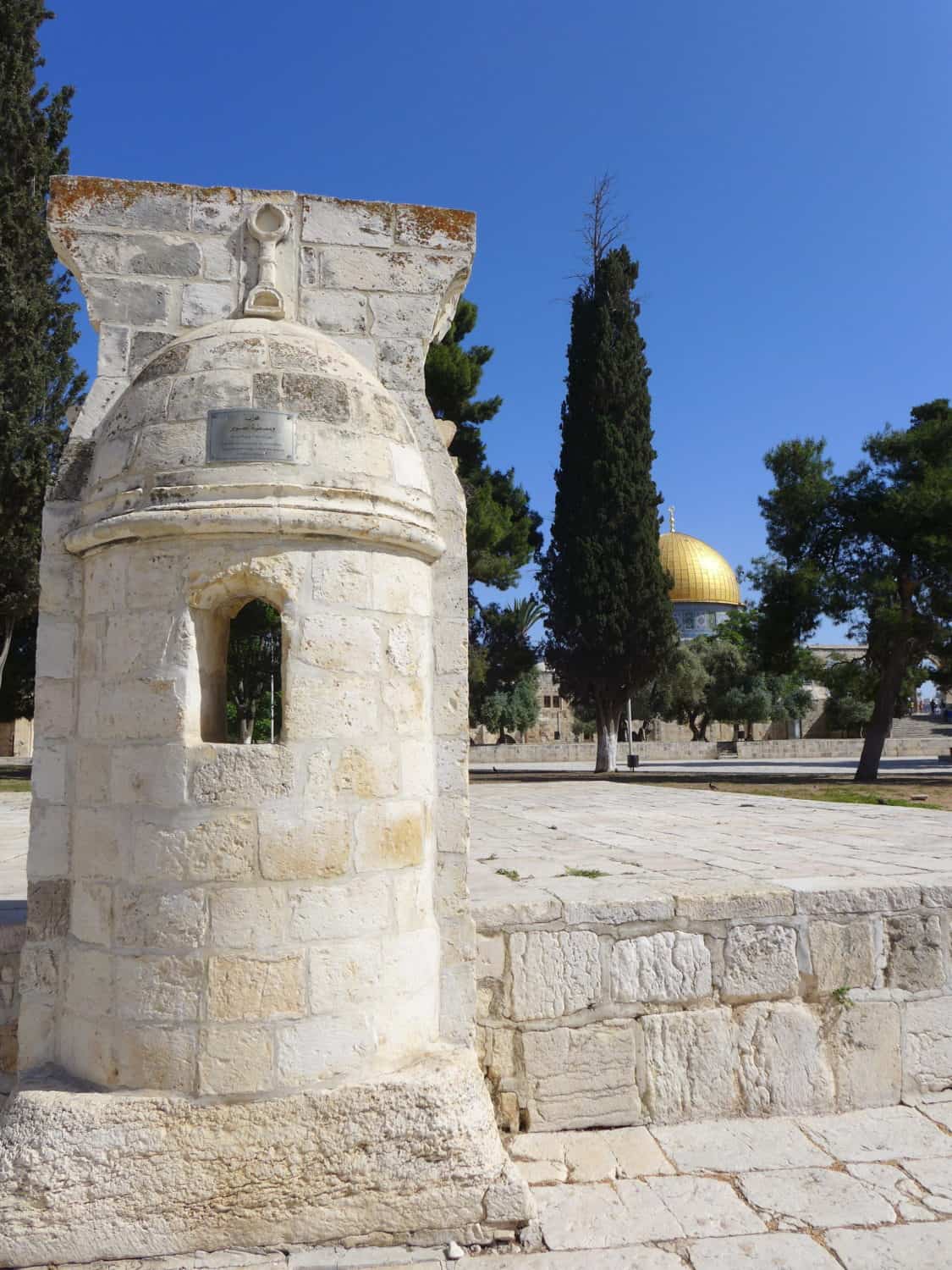
First you’ll see the Al-Aqsa Mosque and the fountain where worshipers can wash themselves…I was obsessed with the bright green and gold on the railing.

Though located in the Old City (which Israel controls), the Temple Mount is under the control of the Jerusalem Islamic Waqf, that was established in the 12th century to manage the Islamic structures in Jerusalem (I believe the Waqf is paid by Jordan but can’t confirm).
You must be well covered and go through strict security screenings to enter the Temple Mount. On the Mount, you’ll find the Dome of the Rock, the Al-Aqsa Mosque, the Dome of the Chain, and four minarets. As a non-Muslim, you won’t be able to enter any of these, but you can see the outside and walk around.
Read next: Driving the Negev Desert: Tel Aviv to the Red Sea
So what is the Dome of the Rock?
The Dome of the Rock is a UNESCO World Heritage Site and a must visit when in Jerusalem. It’s located on the Temple Mount, in the Muslim Quarter, in the Old City and holds great religious significance for both Jews and Muslims. In the Islamic faith, the rock is where Muhammad ascended to heaven, making it the third holiest site for Muslims.
In the Jewish faith, this is The Foundation Stone (among other things) of the temple and the Holy of Holies, and the holiest site in Judaism.

The Dome of the Rock is really stunning—it’s hard to fathom the amount of detail on the tiles. We totally lucked out and there was almost no one there when we visited, allowing me to get some great shots of the building without people. The plaza was quiet and peaceful, a shift from the bustle of the Old City’s narrow streets.

As I mention in the tips below, two things you need to be aware of are the rules around dress, and the rules around co-ed touching. I wore a maxi skirt, v-neck t-shirt, cardigan, and sandals. I should have thrown on a scarf to be safe, because at one point my cardigan came apart and I got yelled at for my v-neck. They are not messing around.
Also, we weren’t even thinking and my dad wanted to get a picture of me and Alejandro, so we threw our arms around each others’ shoulders—and got yelled at. The guard made us delete the picture off his camera (though they hadn’t realized we got one on my phone too, so I still have that). Just be very aware and remember the rules while you’re there.

I was dazzled by the bright colors and incredibly intricate details. The original golden dome was actually made of gold, but was later replaced by copper, and then aluminum (and now covered with gold leaf). Can you imagine how heavy that original all-gold dome was???
Fun fact about Dome of the Rock: it’s not a mosque, it’s a Muslim shrine (the oldest Islamic monument that stands today)
You can read about some other fun facts about the Dome of the Rock, in case you’re interested.
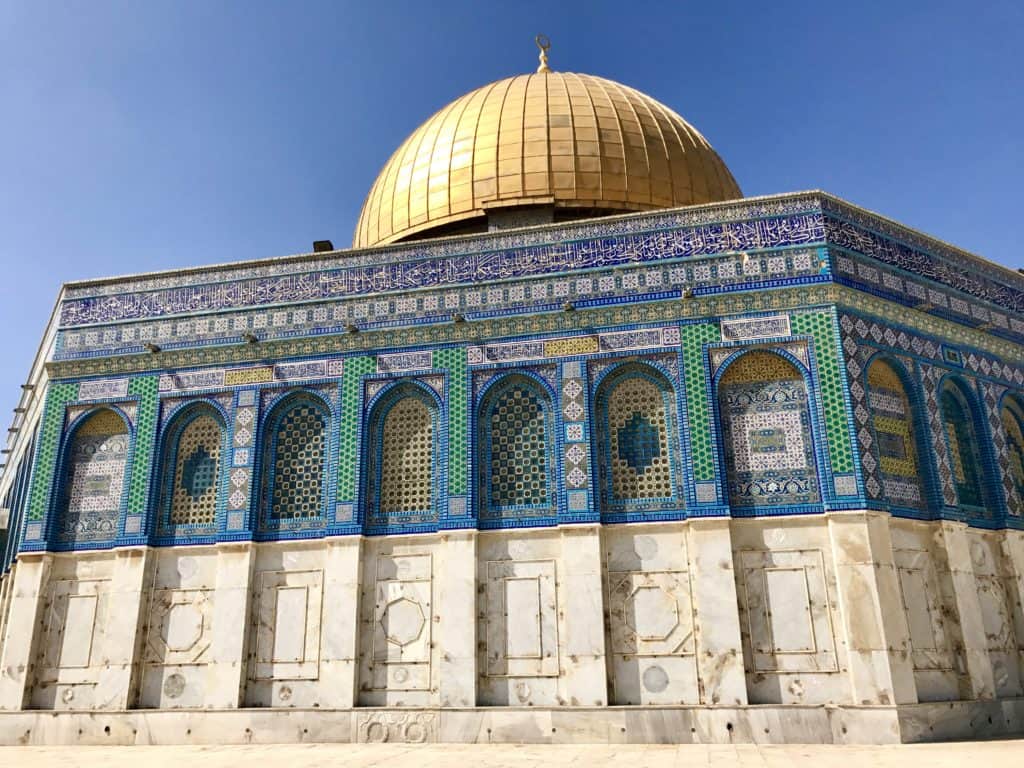
A couple months after we visited, there was a shooting (two Israeli guards were attacked) at the Temple Mount and access was shut down for a couple days, then obviously security was much tighter for a while—which affects wait times. Unfortunately due to the contested nature of the site and the differing viewpoints, unrest does occur sometimes so it’s important to check whether it’s open before you visit (gun attacks, though, have been relatively rare in recent years).

As you’re leaving the Temple Mount, you can see the Golden Gate, thought to be the oldest gate in the Old City. It faces the Mount of Olives and so is where the Jews believe the Messiah will enter the city when he comes, proceeded by Elijah.
You may notice that its most noticeable feature is that it’s completely sealed shut. It’s been closed and reopened a few times over the centuries, but was finally walled up by Suleiman the Magnificent in the 16th century. It may have been for defensive reasons, but it’s believed that he did this (and created a cemetery in front of it) so that the Anointed One could not enter the city according to the prophecies without being made unclean (by the cemetery). It was Suleiman’s “gotcha”. I thought that was a super interesting historical anecdote!

I’ve put together a super detailed full itinerary post, with our whole 7-day Israel and Jordan trip . Let me know in the comments if you have other questions, or just thoughts!
Okay, now to the good stuff…
Tips for visiting the Temple Mount
- Non-Muslims can only enter the Temple Mount via the wooden walkway at the Western Wall plaza
- No weapons are allowed, and visitors can’t bring in any sacred objects (such as a prayer book or talit). I read before my trip that if you even have a souvenir or something with the Star of David or some other Jewish symbol that they won’t let you take it in, so be aware.
- Make sure to bring your passport, you may be asked to show it.
- Don’t bring laptops or tablets, they may be confiscated for the duration of your visit.
- Both men and women need to be dressed modestly, clothes should be loose-fitting, and sandals are permitted
- Men should wear long pants and a shirt that covers their shoulders
- Women need long pants or a long skirt with a shirt that covers shoulders and elbows. You don’t need a head scarf. I wore a long maxi skirt, a t-shirt and a cardigan (I should have had a scarf over my neck too, to avoid getting yelled at).
- Non-Muslims can visit Monday through Thursday, it’s closed to visitors on Friday and Saturday. During peak tourist season you might want to get there a half hour or hour early to line up.
- Winter hours are 7:30-10:30am and 12:30-1:30pm
- Summer hours are 8:30-11:30am and 1:30-2:30pm
- However, the entrance can be closed without notice even during normal hours, so I recommend getting on the TripAdvisor forums right before your trip to make sure things haven’t changed. It’s best to hear what’s going on from locals on the ground.
- Only Muslims can enter Dome of the Rock or Al-Aqsa Mosque
- Men and women are not allowed to touch each other (even family members), so keep that in mind
- We stayed at Abraham Hostel in Jerusalem (in Tel Aviv too) and it was a perfect place to base ourselves. It’s a fairly easy walk to the Old City (or a couple tram stops) and only two minutes’ walk to Mechane Yehuda Market (aka The Shuk). We also took their tour for a sunrise hike up Masada and visiting Ein Gedi and the Dead Sea (more about that here , sunrise at Masada is a bucket list must!).
Other interesting historical religious explorations you’ll like:
- A Day Trip to Bulgaria’s Rila Monastery
- 24 Hours in Istanbul: Mosques, Hagia Sofia, and More
- Mesmerized by Petra at Night
- Zelve, the Best-Kept Secret in Cappadocia
Pin this image!

Comments (3)
A Precious City, Jerusalem – The Black & The City
October 28, 2020 at 7:36 am
[…] https://www.onegirlwholeworld.com/unique-experiences/how-to-visit-temple-mount-jerusalem/ […]
Places to Visit in Tel Aviv & Old Jaffa | One Girl, Whole World
June 16, 2018 at 7:20 pm
[…] You might also like: How to Visit Jerusalem’s Western Wall, Dome of the Rock, & Temple Mount […]
From Tel Aviv to Eilat: Through the Negev Desert | One Girl, Whole World
April 10, 2018 at 7:11 am
[…] You might also like: How to Visit Jerusalem’s Temple Mount, Dome of the Rock, & Western Wall […]
Leave a comment
Your email address will not be published. Required fields are marked *
Notify me of followup comments via e-mail. You can also subscribe without commenting.
This site uses Akismet to reduce spam. Learn how your comment data is processed .


Fancy Afternoon Tea at London's The Langham

Drinking in the Beauty & History of Slovenia's Julian Alps
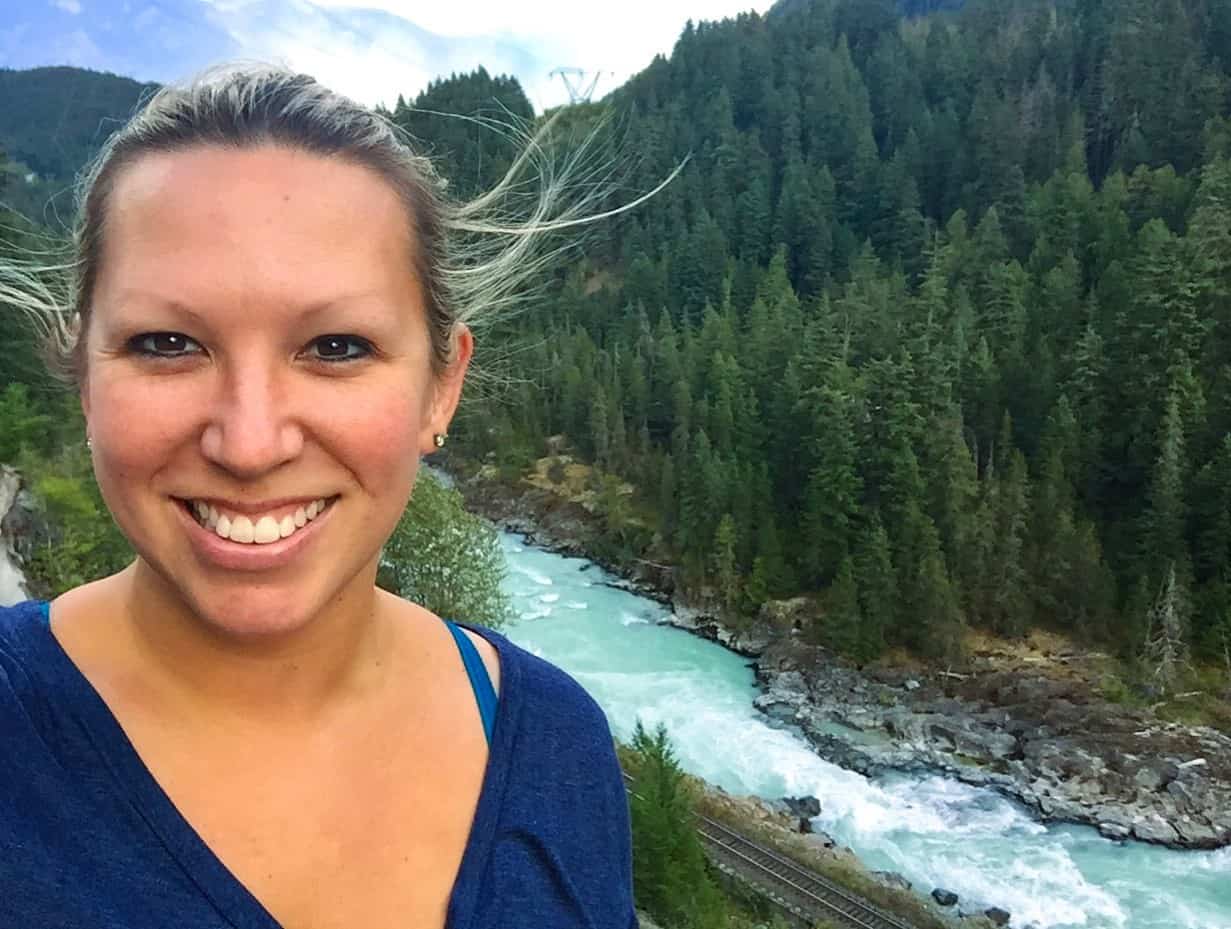
I'm Jessica!
Who am I? I’m not a digital nomad or backpacker. I have a demanding full-time career but still find ways to fit in tons of travel. I believe that sometimes you save and sometimes you splurge, and I’ll help you figure out how to have the best experiences regardless. My goal is to go everywhere, see everything, eat all the pastries, and soak up as much food, wine, culture, and amazing views as I can in this crazy life!
Looking For Something?
Instagram adventures.

Affiliate Disclosure

Fresh Stuff!

A Fun & Chill Girls' Trip Weekend: Things To Do In Charleston (SC)

Visiting South Africa's Famous Penguins: A Stop At Foxy Beach & Boulders Beach

Why You Have To Take A Ponte de Piedade Boat Tour In Portugal's Algarve

Where To Stay In San Juan, Puerto Rico: A Review Of Condado Ocean Club
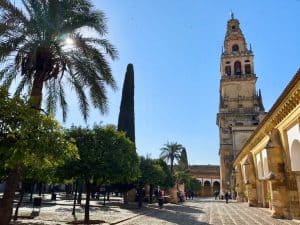
What To Do With A Half Day In Cordoba: Is This Day Trip From Seville Worth It?
Locations written about.


Visiting the Temple Mount in Jerusalem as a tourist

As shared in the previous post on the Western Wall in Jerusalem, we did not get to visit the Temple Mount, because we had missed the opening hours. 🙁 That being said, I think it’s important to flag out some key aspects before one decides on visiting the Temple Mount in Jerusalem as a tourist. Hence my post below.
The visiting hours of Temple Mount are pretty short, so you’ve got to take note of the timings for a successful visit.
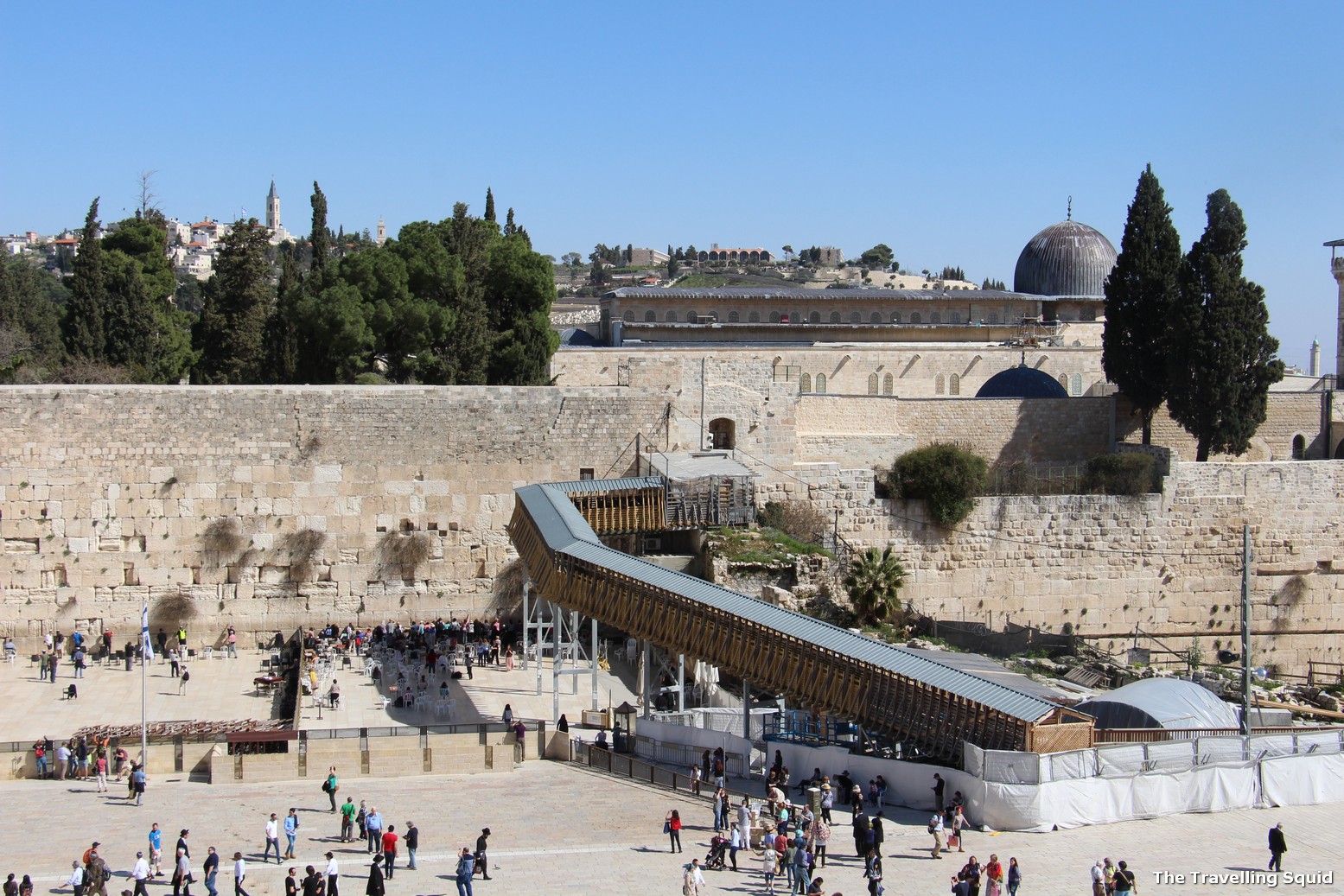
It also took us awhile to figure out where the entrance to Temple Mount was. I later realised that the entrance is located at the Western Wall. That long passageway at the Western Wall could be it (See picture above).
- Summer: Sunday to Thursday: 8:30am to 11:30am and 1:30pm to 2:30pm
- Winter: Sunday to Thursday: 7:30am to 10:30am and 12:30pm to 1:30pm
Also make sure that you’re appropriately dressed – no shorts or bare shoulders. This can be overcome by carrying a shawl with you. For security checks, it might be helpful to bring along your passports. This post from The Whole World Is A Playground is particularly useful in identifying some key things to look out for in order to enter Temple Mount.
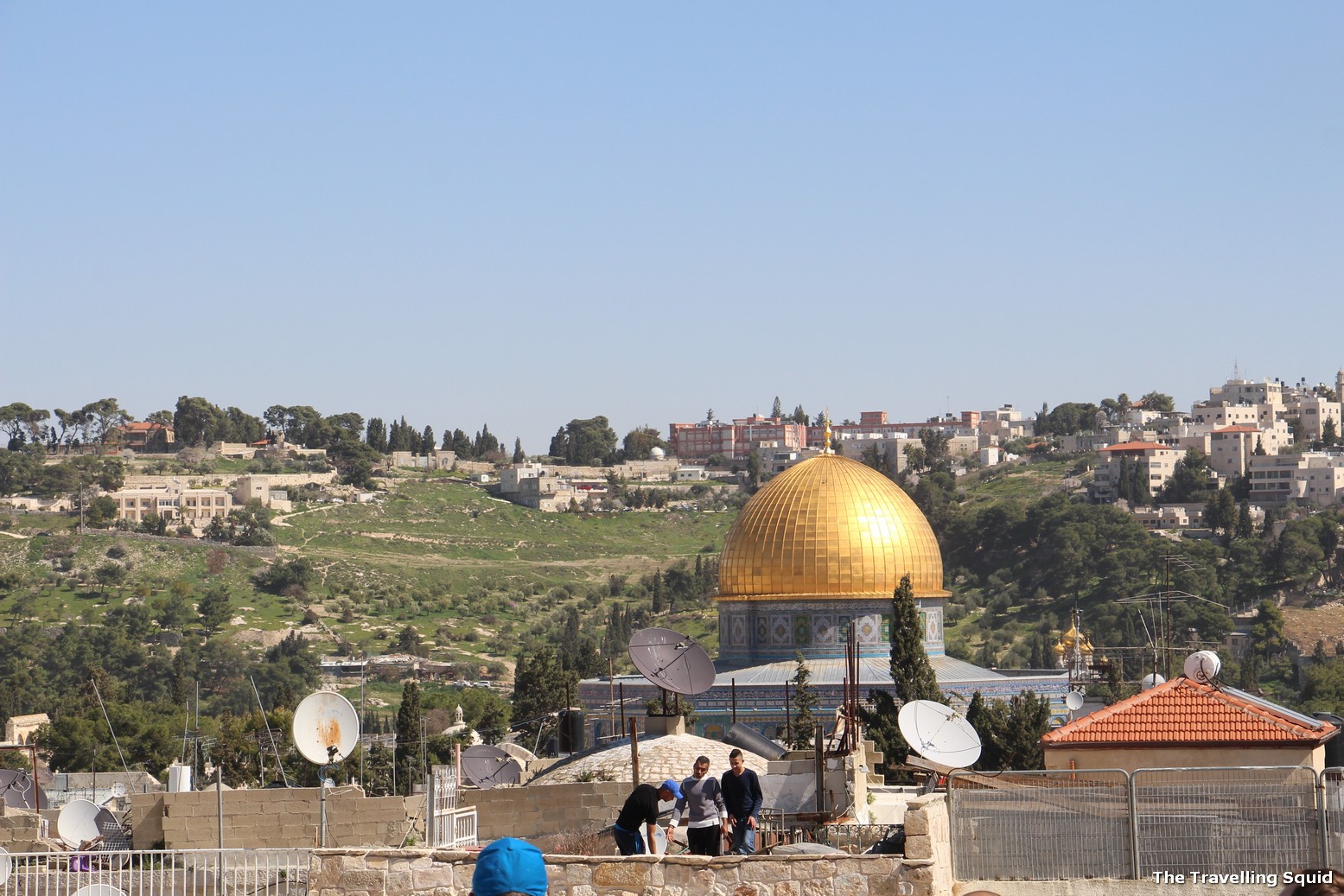
According to Wikipedia , the Temple Mount is dominated by three monumental structures from the early Umayyad period : the al-Aqsa Mosque , the Dome of the Rock and the Dome of the Chain , as well as four minarets . Herodian walls and gates with additions dating back to the late Byzantine and early Islamic periods cut through the flanks of the Mount. Currently it can be reached through eleven gates , ten reserved for Muslims and one for non-Muslims, with guard posts of Israeli police in the vicinity of each.

Today, the Temple Mount remains to be a focal point in the Arab-Israeli conflict, and prayer by non-Muslims is banned, in the government’s bid to enforce the status quo. There is only one point of entry for tourists, hence this post’s title.
The Travelling Squid’s Take
I was pretty sad to learn that we had missed the opening hours to Temple Mount. That being said, admiring the Dome of the Rock from the roof tops of someone’s home is not too bad too. I wonder what it would be like living in the Old City, surrounded by renowned monuments, which are the contention of so many. It’s like a calm lake with deep undercurrents.
More from The Travelling Squid

© 2024 The Travelling Squid
Powered by Pinboard Theme by One Designs and WordPress
- Work With Us
How to Visit the Dome of the Rock in Jerusalem
Written by Becca
Updated on November 6th, 2023
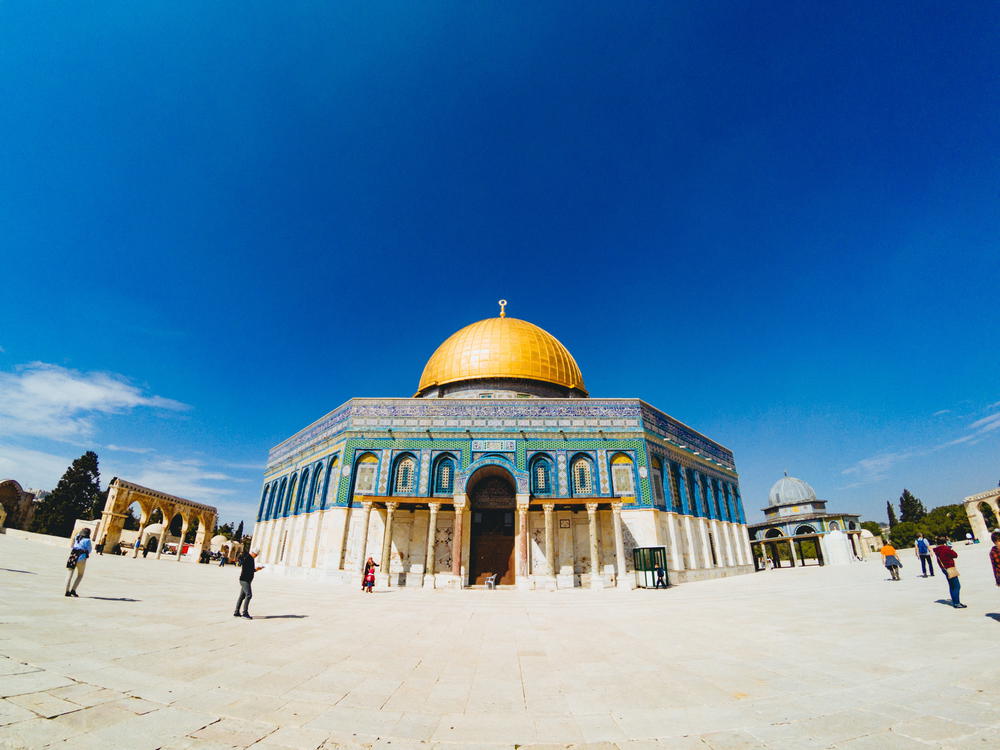
Visiting the Temple Mount and the Dome of the Rock, which is one of the most important Muslim sites in the world, requires some planning and preparation. Here's how to plan the most efficient trip for your visit to this extraordinary cultural place.
This article may contain affiliate links. We earn a small commissions when you purchase via those links — and it's free for you. It's only us (Becca & Dan) working on this website, so we value your support! Read our privacy policy and learn more about us .
Posted in Israel
Table of contents
- What should you bring to Dome of the Rock?
- What should you not to bring to Dome of the Rock?
- When can you visit Dome of the Rock?
- What’s the Dome of the Rock security like?
- What is inside the Temple Mount Complex?
- Why is the Dome of the Rock important?
As per a Travel Advisory update posted by the US Department of State on October 14, 2023, Israel has been marked a Level 3 Country: “Reconsider travel” due to the ongoing armed conflict, civil unrest and terrorism from “Hamas, a U.S. government-designated foreign terrorist organization.” Please visit the travel.state.gov page for Israel to learn more and stay informed.
After you’ve explored Tel Aviv and gotten your bearings in Jerusalem, you can start planning your visit to one of the most visited places in the world, the Dome of the Rock.
Even though we had both been to Israel before, we had not been to the Dome of the Rock due to some factors. For one thing, going to the Dome of the Rock requires waiting in line, and the visiting hours are pretty specific. Second, you have to come prepared.
Visiting the Temple Mount and the Dome of the Rock , which is one of the most important Muslim sites in the world, requires some planning and preparation.
Here’s how to plan the most efficient trip for your visit to this extraordinary cultural place. If you’d like to access the Dome of the Rock, we’ve listed six things to help you get the most out of your visit.
What should you bring to Dome of the Rock?
The Temple Mount is a very important place in the Islamic religion, so it is important to dress modestly. Men should avoid shorts and tank tops and opt for pants and T-shirts with sleeves instead.
For women, legs, neck and arms should be covered to stay safe. It is advisable to bring a scarf in winter or lightweight shawl or pashmina for summer. I wore yoga pants, and this did not qualify as pants when I entered, so I was given a free rental skirt in a nice turquoise hue.
I wore a zip-up hoodie to cover my arms, and I was instructed to wrap my light scarf around my neck to cover up. If you plan to visit in summer, you can also bring your own floor-length skirt or wrap.
Looking for a great travel hoodie? Check out our review of the First Class Merino Hoodie by Aviator.
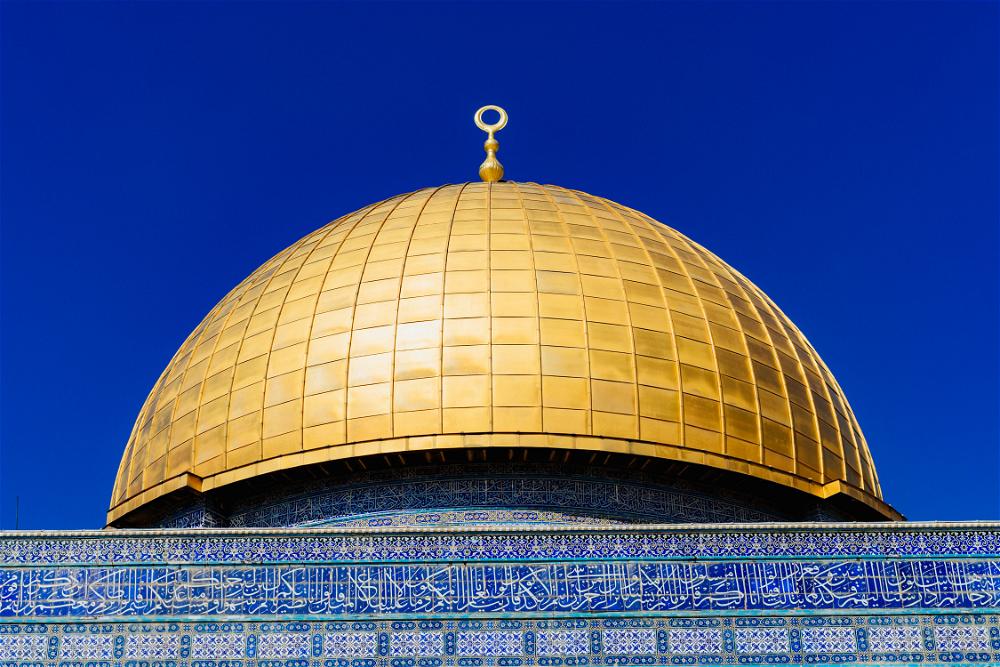
What should you not to bring to Dome of the Rock?
Here are a few things that are not allowed in the Temple Mount (guards will check your bags, so there is no way around this): any Jewish objects such as prayer books, tefillin, tallit, flags or other religious Jewish objects.
This is good to keep in mind if you plan to go shopping for souvenirs or gifts in the Jewish Quarter of the Old City on the same day of your trip. You can do the shopping afterward, or leave these items at your place of accommodation.
In regard to camera gear, we overheard that tripods are not allowed into the Temple Mount area. If you plan to be out for the day, leave your tripod at home!

When can you visit Dome of the Rock?
Visiting the Dome of the Rock requires planning, as the open hours center around hours of Muslim prayer. The hours are different in winter and in summer for this reason.
It’s advised to check the schedule before working a trip to Dome of the Rock into your day, but we did not have a problem. For the 1pm opening, we arrived at 12pm on the dot and were the tenth people in line for security.
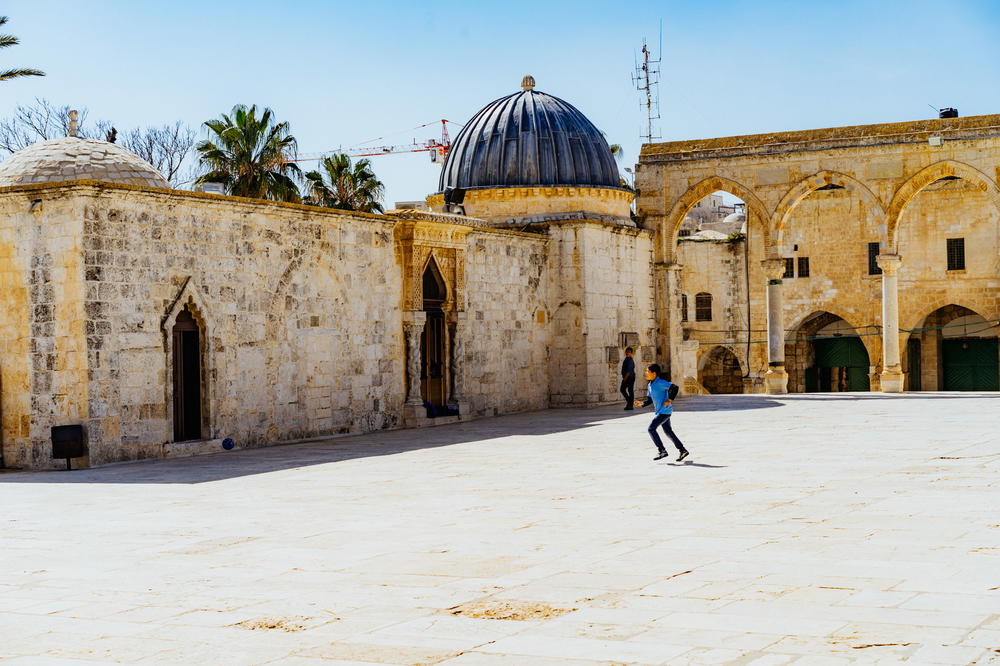
What’s the Dome of the Rock security like?
Security is airport-style for entrance into the Temple Mount complex. When summoned by guards, you will proceed to a metal detector and all your bags will go through a scanner.
Guards will look at your passport and may question you about your intentions for your visit. If you are Jewish, you may be taken aside and questioned privately, with guards reminding you to not make any remarks to anyone about Judaism while inside, for your safety.
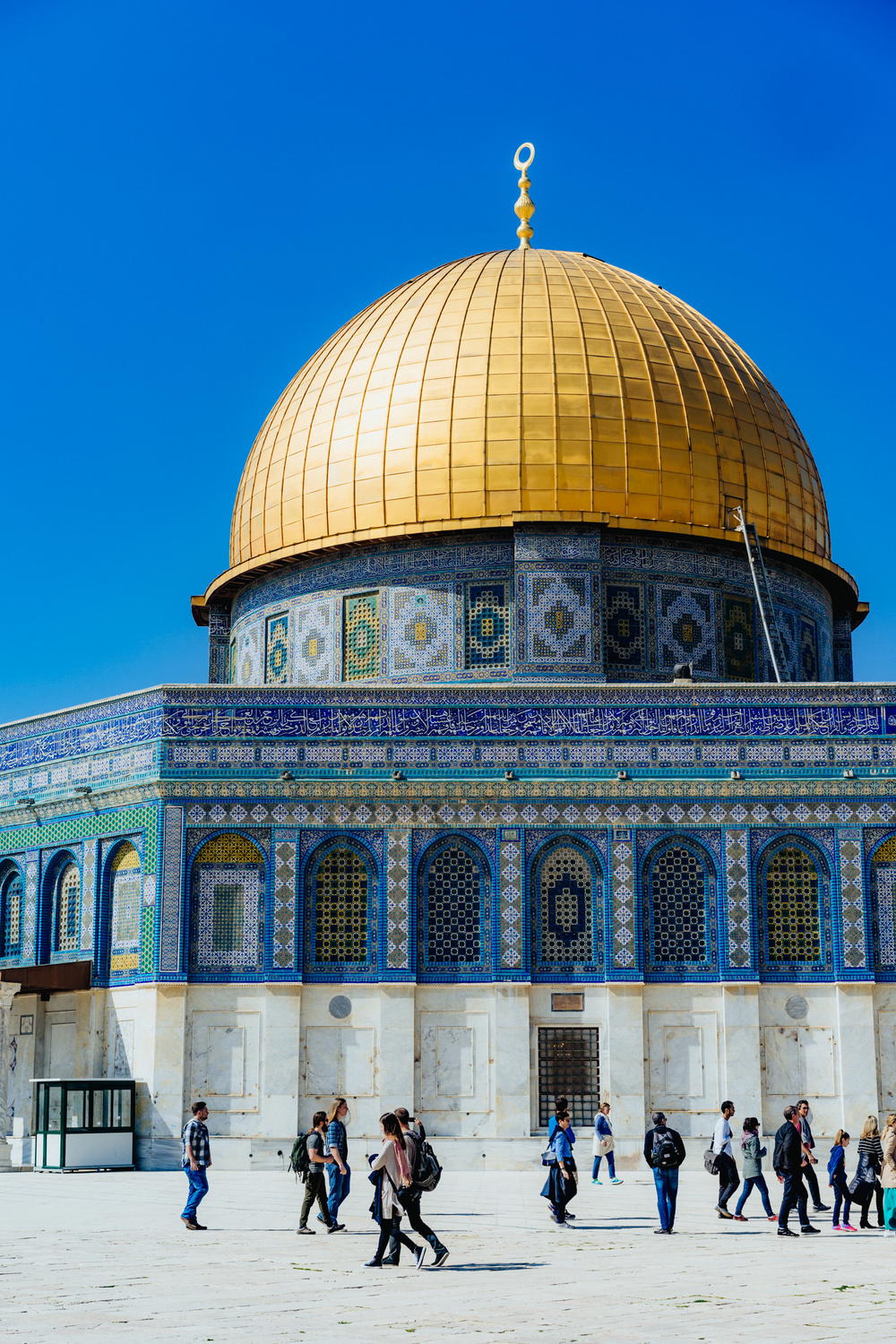
What is inside the Temple Mount Complex?
Once inside the Temple Mount complex, you will feel like you’ve entered another world. The most striking thing is that on one side of a wall is the holiest place in Judaism, the Western (Wailing) Wall, and on the other is a place where daily Muslim life is going on and a call to prayer is broadcasted multiple times per day over loudspeakers.
There are people going to pray, there are children tossing around soccer balls and there are people coming to meet each other.
While visiting, we felt very safe, and it is permitted to take photos of nearly anything, as long as you are not getting in anyone’s way. The Dome of the Rock itself is an incredibly beautiful building and is one of the most famous pieces of architecture in the world.

Why is the Dome of the Rock important?
Visiting the Temple Mount and Dome of the Rock is one of the most interesting things you can do in Jerusalem and it is an excellent learning experience as well. It’s important to remain respectful and keep in mind all of the scheduling and security precautions in order to have a seamless visit there.
You may also like
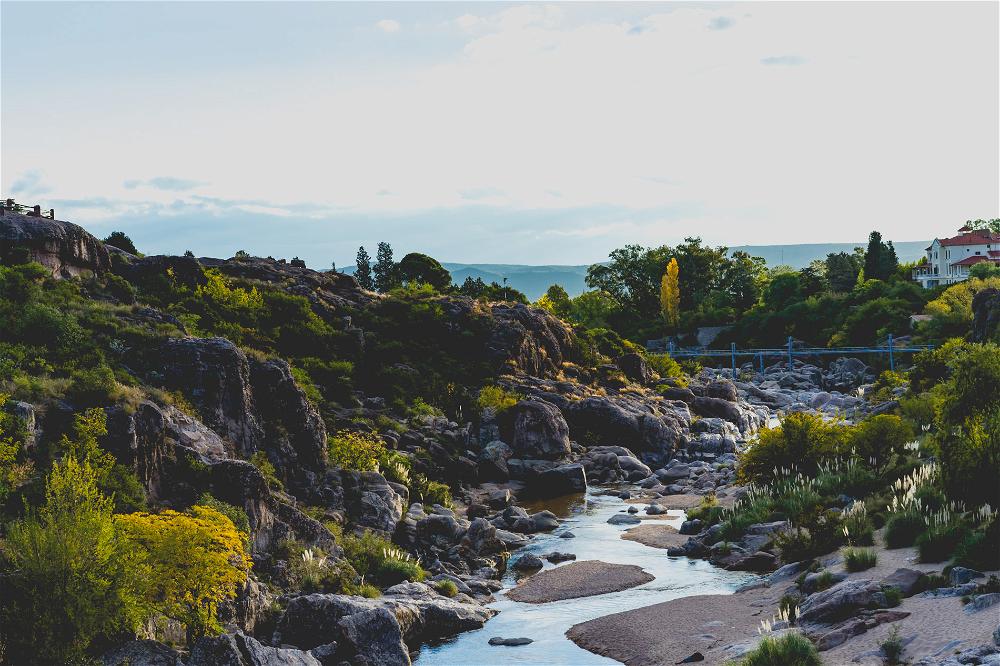
Road Trip in the Cordoba Sierras
The Sierras and Valle de las Traslasierras Region of Argentina is not well-known like Patagonia, but it’s worth a trip there to get a taste of Argentina’s central region. You can spend some time in the Sierras after getting acquainted with the provincial capital of Cordoba province, the Ciudad de Cordoba.
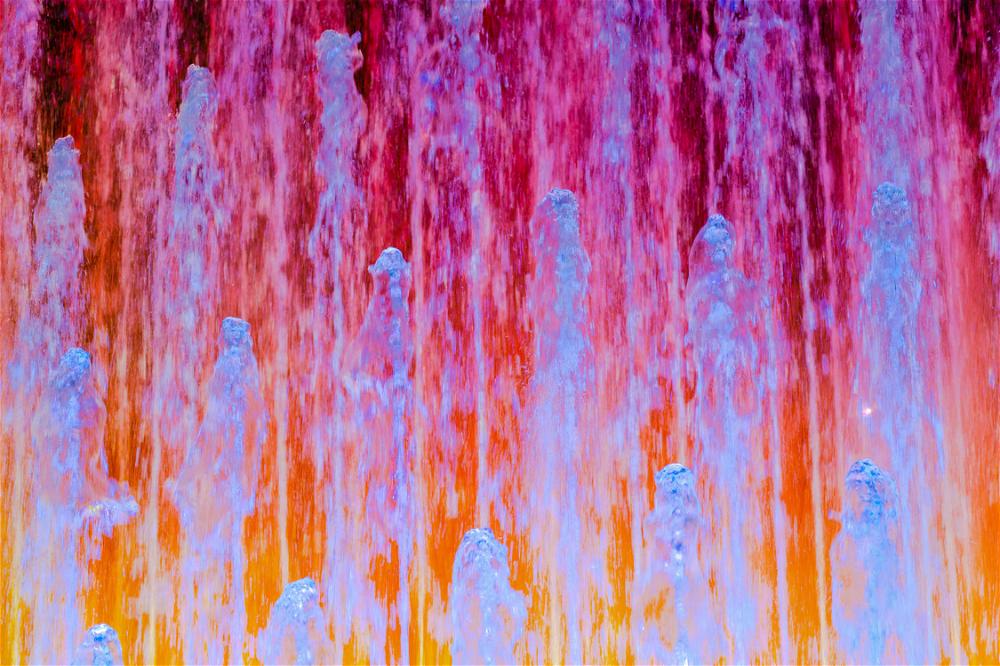
Exploring Parque De La Reserva in Lima, Peru
Where did we find rainbows in Lima? We stayed in the city''s Parque de la Reserva after the sun set, when all the fountains are illuminated with rainbow lights.

Make Nine Coliving Your Next Digital Nomad Destination
We found home and community at Nine Coliving, a beautiful historic mansion that has been transformed into a co-living and co-working house in the Canarian colonial town of La Orotava.
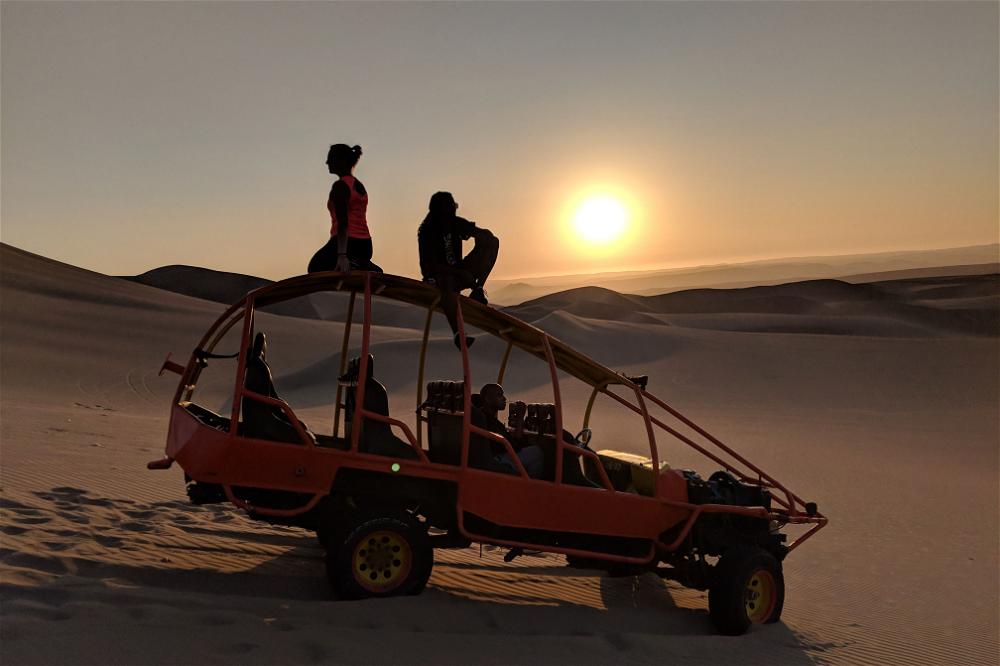
Huacachina Sandboarding & Riding Dune Buggies in Peru
Going sandboarding in Peru is what we thought was a once-in-a-lifetime experience - that is, until we both did it twice! After going sandboarding and dunebuggying, watching the sun set from the top of a dune in the Peruvian desert is awesome!

Pittsfield/Berkshires Travel Guide (Restaurant Guide and Things to Do)
Thinking of where to stay and towns to visit in the Berkshires? See the best things to do in Pittsfield, Mass, in this travel guide with what to do during a long weekend trip.
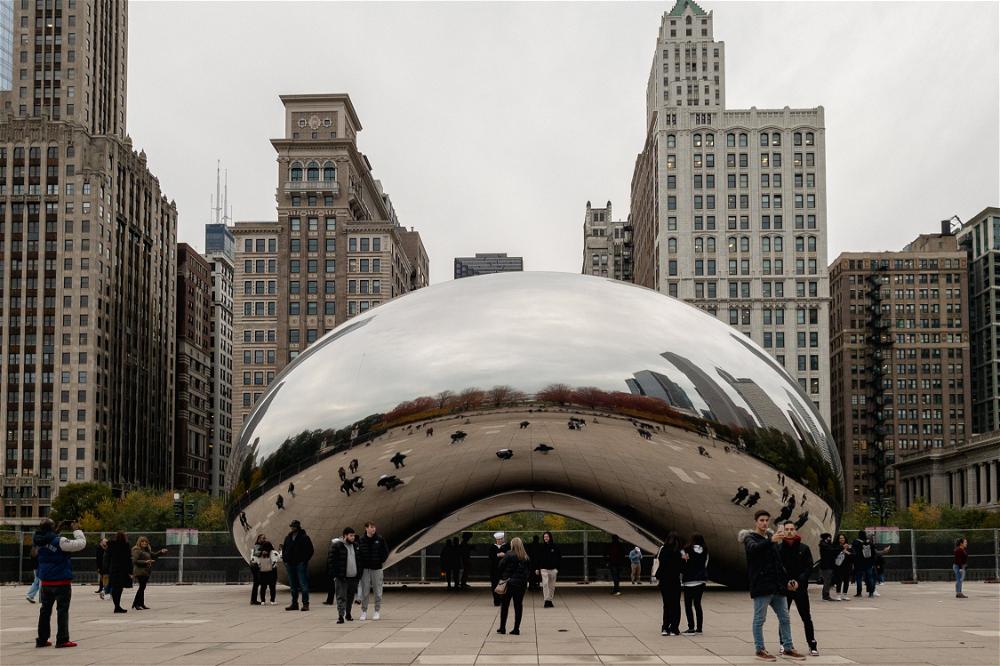
Best Chicago Street Photo Spots
Where are the best Chicago street photography locations? We checked out some of the best hidden photography spots and the best places for Instagram shots in Chicago in this list.

Olá ! We’re Becca & Dan.
We created this blog to share some of the knowledge and experience that we have around travel , remote work , photography and beyond!
We're currently drinking seltzer water, we love it.
Join the club
You’ll get emails with our latest articles, tips, advice and so much more! You won't find this content anywhere else!
This website may contain affiliate links. We earn a small commissions when you purchase via those links — and it's free for you. It's only us (Becca & Dan) working on this website, so we value your support! Read our privacy policy and learn more about us .
Among other programs, Half Half Travel is a participant in the Amazon Services LLC Associates Program, an affiliate advertising program designed to provide a means for us to earn fees by linking to Amazon.com and affiliated sites.
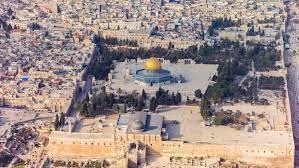
Back to the Templemount.org Homepage

Exploring Haram al-Sharif (Temple Mount): A Visitor's Guide
Written by Jess Lee Updated Jan 15, 2021
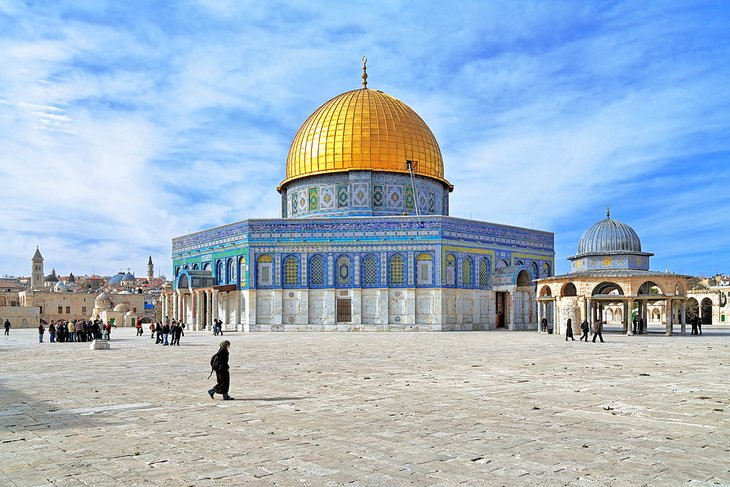
The Haram al-Sharif is one of the most contentious pieces of land in the world, as well as being Jerusalem's most recognizable landmark.
For the Jewish faith, this marks the spot where the world was first created, and where it will end.
Muslims believe that the Prophet Muhammad ascended to heaven from here on his M'raj journey.
For all three major monotheistic faiths (Jews, Christians, and Muslims), the Haram al-Sherif is the place where the Prophet Abraham stood ready to sacrifice his son to prove his faith to God.
First the site of the Israelites' First and Second Temples, and now home to the Dome of the Rock, this small plot of land has been fought over across the centuries and remains a place of deep religous significance and faith.
The Enclosure Walls
Temple platform, al-aqsa mosque, dome of the rock platform buildings, dome of the rock, tips and tactics: how to make the most of your visit to haram al-sharif, getting there, history of haram al-sharif.
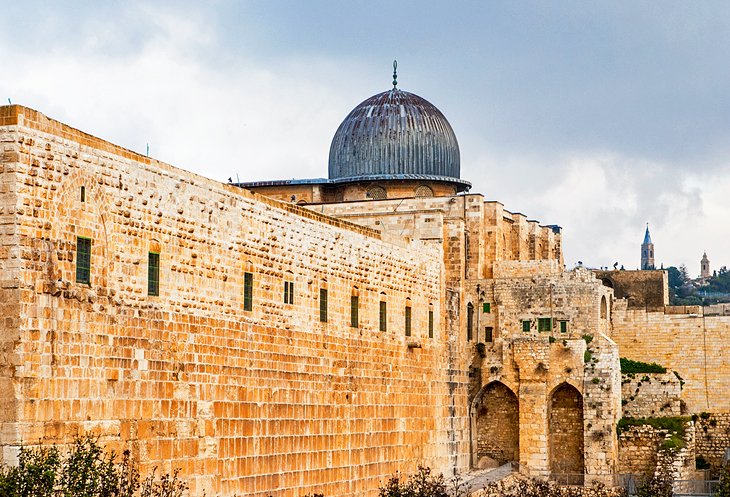
The walls enclosing the Haram al-Sharif reach their highest point (65 meters) at the southeast corner, where there is a clear view of the massive blocks of dressed stone of the Herodian walls and the overlying courses of smaller stones of later restorations.
There are seven gates leading up to the plaza but non-Muslims can only enter through Bab al-Magharibeh .
If you decide to take a tour around the walls, the four other major gate entrances are the Chain Gate (Bab es-Silsileh); the Cotton Merchants' Gate (Bab al-Qattanin), which displays an excellent example of stalactitic corbelling; the Iron Gate (Bab el-Hadid); and the Watchman's Gate (Bab en-Nazir).
On the western and northern walls are four minarets with a range of construction dates: at the southwest corner (1278, altered 1622), above Bab es-Silsileh (1329), at the northwest corner (1297), and — the youngest of the four — on the north wall (1937).
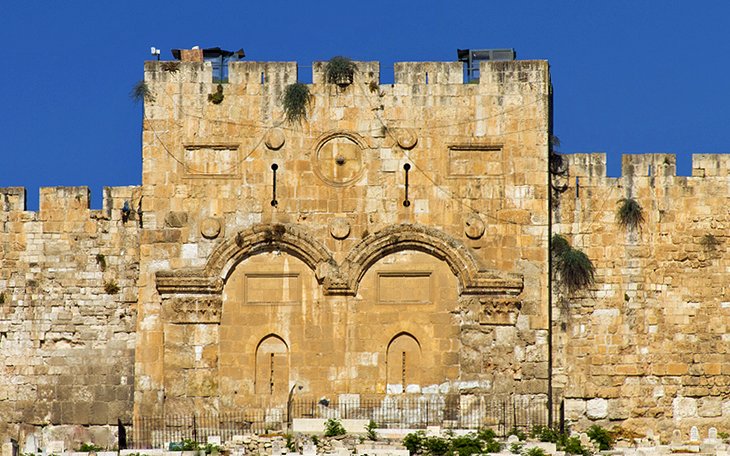
One of the most interesting tourist attractions of the walls is the bricked-up Golden Gate, a double gateway through which Jewish tradition states the Messiah will enter the city on the day of the last judgement.
Accordingly — and undoubtedly also with strategic considerations in mind — the Arabs walled up both gateways and for good measure laid out a cemetery outside the walls here.
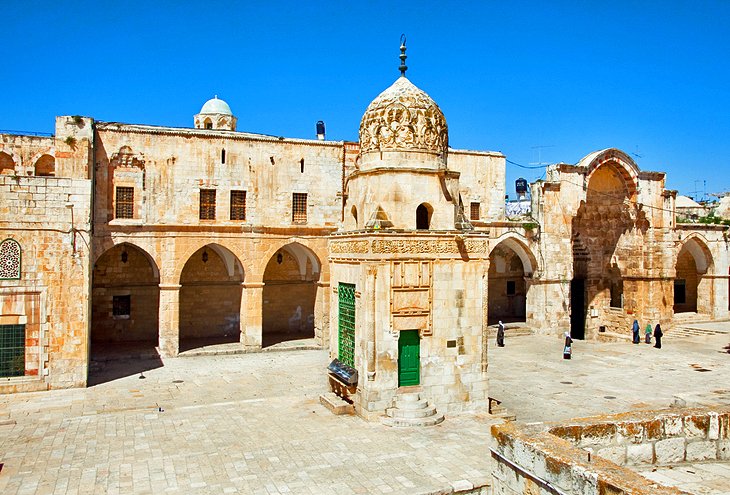
The site of Solomon's First Temple is now a spacious plaza.
The western side features some arcaded Mameluke-era buildings. Between the gates of Bab al-Qattanin and Bab el-Hadid are a number of tombs, including that of Sharif Hussein I Ibn Ali (1851-1931), leader of World War I's Arab Revolt.
At the southeast corner, a flight of steps leads down to the so-called Solomon's Stables (usually closed), a series of chambers built by Herod the Great, where the later Crusaders tethered their animals.
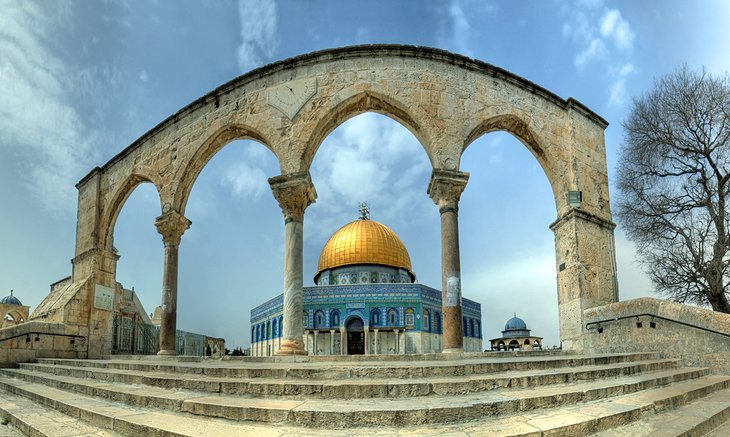
The steps that lead up to the central platform, where the Dome of the Rock sits, are spanned by handsome arched columns dating from the Mameluke period.
Muslims call these the "Scales" as they believe that the scales used to weigh the souls of men will be hung from here on the Day of Judgement.
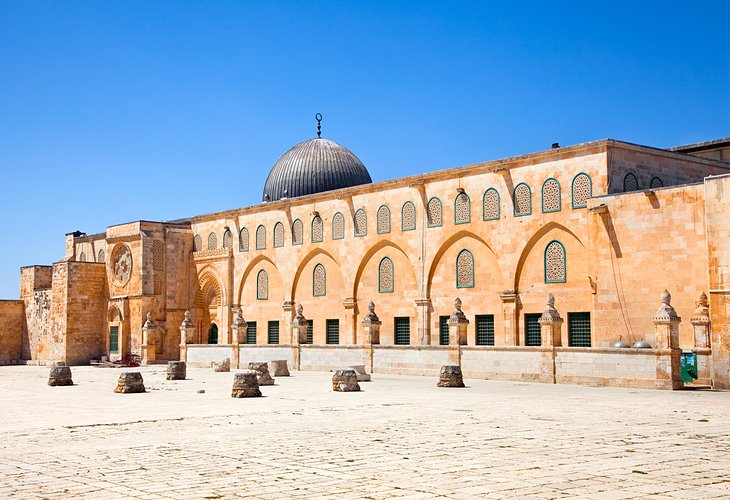
Al-Aqsa Mosque ("The Farthest Mosque") takes its name from the Prophet Muhammad's journey to heaven (known as al-Isra wal Mi'raj or "the night journey" by Muslims) in which he traveled from Mecca to the farthest mosque before ascending to heaven.
Archaeologists believe that the mosque stands on the marketplace site of the Jewish Temple Mount.
The original mosque was built during the reign of the Umayyad Caliph Al-Walid I (AD 705-715), and some archaeologists believe that the builders overlaid a Byzantine-era basilica in the construction, though there is dispute about this.
When the Crusaders arrived in Jerusalem, they decided the mosque was the true site for Solomon's Temple.
Across the centuries, Al-Aqsa has been extensively restored and renovated, most recently between 1938 and 1943, when columns of white Carrara marble, supplied by Mussolini, were installed and a new ceiling was built at the expense of King Farouk of Egypt.
In 1967, it was damaged by gunfire and in 1969, a fire deliberately started by an Australian Christian, destroyed some of the priceless 12th-century interior detail.
Despite this, the seven-aisled interior is impressive and is home to a striking and intricately-carved mihrab (prayer niche). Outside the front of Al-Aqsa is the El-Kas ablution fountain, erected by the Mamluk Sultan Qaitbay in 1455.
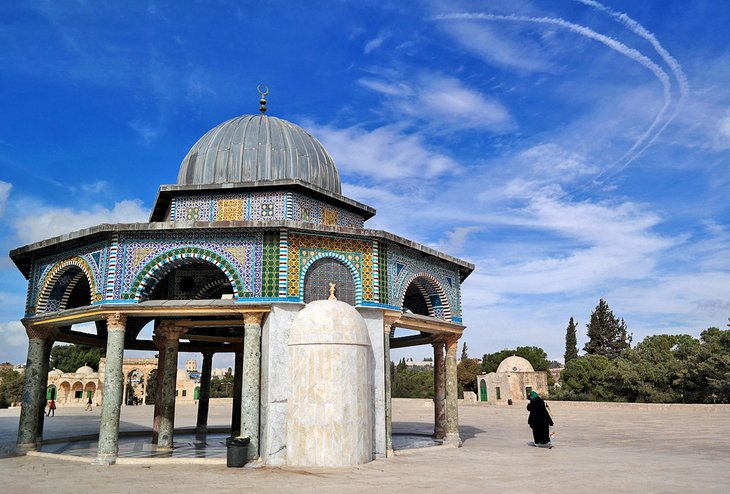
On the Dome of the Rock's eastern side is a small circular domed building known as the Dome of the Chain , so called because Solomon is said to have hung a chain over his father's place of judgement from which a link would fall if any man appearing for judgement swore a false oath.
The large mihrab (prayer niche), marking the direction of Mecca, dates from the 13th century.
At the northwest corner of the raised platform is the Dome of the Ascension , built on the spot where, in Muslim belief, the Prophet Muhammad prayed before his ascent to heaven.
In the northwest corner, in front of the staircase are the Dome of St. George and the Dome of the Spirits, which date from the 15th century.
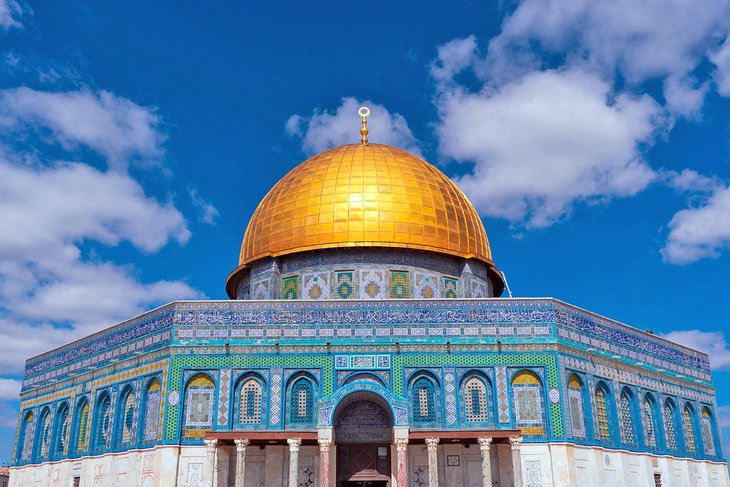
The main sightseeing attraction upon the platform is of course the Dome of the Rock itself.
Non-Muslims cannot enter, but the façade is beautiful. Built over the site where Jews believe Abraham prepared to sacrifice Isaac, and Muslims believe the Prophet Muhammad began his ascent to heaven, the Dome of the Rock (Qubbet el-Sakhra) is one of the greatest of Muslim monuments.
It was built by Abd al-Malik (685-705), the fifth Umayyad Caliph. The octagonal structure, with a high dome, enshrines the sacred rock of Moriah.
The impressive effect of the Dome of the Rock results from the combination of fine proportions and sumptuous decoration with an apparently simple ground-plan consisting of three concentric elements.
Around the rock is a ring of piers and columns supporting the dome; a broad ambulatory separates this ring from an octagon, also formed by piers and columns, and this in turn is separated from the octagonal outer walls by a narrow ambulatory.
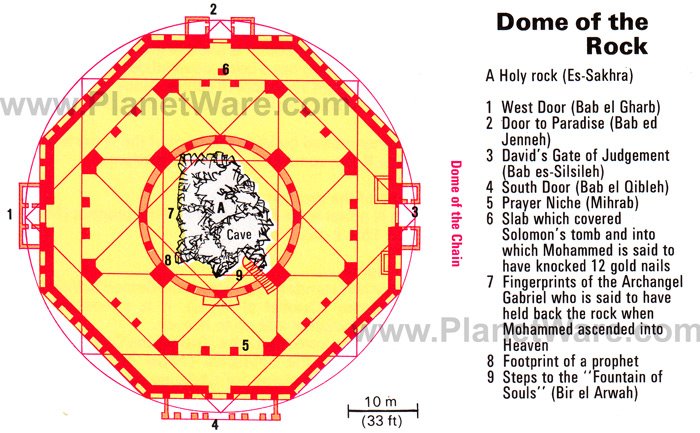
Four doors, clad with copper by Qaitbay (1468-96), lead into the interior, which is unfortunately off-limits to non-Muslims.
In the center of the inner rotunda is Es-Sakhra, the Holy Rock , over which the Jews' altar for burnt offerings may have stood. Just under 18 meters long by 13.25 meters across, it is surrounded by a grille installed by the Crusaders in the 12th century to prevent relic collectors from breaking off pieces of the stone.
Under the rock is a cave, known to Muslims as Bir al-Arwah ("Well of Souls"), where it is believed that the souls of the dead gather to pray.
- Non-Muslims can only enter from the Bab al-Magharibeh, next to the Western Wall in the Western Wall Plaza.
- Get here as early as possible. Security checks mean lines at the entry can be long and tiresome.
- You can exit from any of the other gates. Exit from the Bab al-Qattanin to admire its grand stalactite architecture.
- You are entering one of the holiest sites in the world - dress modestly.
- From Central Jerusalem, Egged Bus No. 38A runs from King George V Street through the Jewish Quarter and to the Western Wall Plaza and related tourist attractions.
- If you're walking from Central Jerusalem, Jaffa Gate is the nearest approach into the Old City.
For those of the Jewish faith, the Temple Mount is where the world began, with God bringing forth the earth, Adam, and Eve from the foundation stone of Mt Moriah.
It was on this same stone that the Prophet Abraham signaled his devotion to God by agreeing to sacrifice his son.
The First Temple built on this spot was constructed by King Solomon with the Ark of the Covenant stored inside. The First Temple was completely destroyed by Nebuchadnezzar in 586 BC.
Later, a Second Temple was built here, which was obliterated by the Romans in AD 70.
Before the Muslims captured Jerusalem, the city was held by the Byzantine Empire, and Emperor Justinian dedicated a church to the Mother of God on the Temple Mount site.
After the Muslim armies conquered Jerusalem in AD 638, Caliph Omar visited the city. Simply dressed, and accompanied by Archbishop Sophronius, he entered the Temple precinct and said a prayer on Abraham's rock, which those of the Muslim faith believe to have been the site from where Prophet Muhammad ascended to heaven.
The brilliant period of the Umayyad Caliphs, whose capital was in Damascus, saw the erection on the Temple platform of the two buildings that have become the landmarks and emblems of Jerusalem - the Dome of the Rock, built over the rock of Moriah by Abd el-Malik in 687-691, and the Al-Aqsa Mosque by his son El-Walid I (705-715).
The period of Muslim rule on the Temple Mount was interrupted by the coming of the Crusaders, who held Jerusalem from 1099 to 1187 and plundered the Dome of the Rock and the El-Aqsa Mosque (less generous than Caliph Omar, who had spared the church of the Holy Sepulchre).
The first kings of Jerusalem resided in the Al-Aqsa Mosque but later made it over to the Order of the Temple (founded 1149), which took its name from the Templum Salomonis (Al-Aqsa) and Templum Domini (Dome of the Rock).
After Jerusalem was recaptured for Islam by Saladin in 1187, there was much further building on the Temple platform, particularly by the Mamelukes.
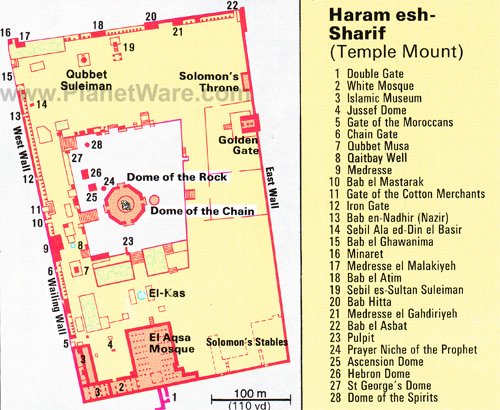
More on Israel
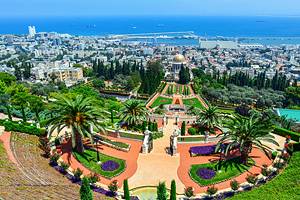
- Travel/Study
BIBLE HISTORY DAILY
The temple mount.
Where Is the Holy of Holies?

by Asher Selig Kaufman
Jerusalem: Har Year’ah Press, 2004, 184 pp. $40 (plus $19 shipping; available from [email protected] )
Reviewed by Joshua Schwartz
There is no site holier for the Jewish people than Jerusalem’s Temple Mount, on which the Biblical and Second Temple period Temples stood. Yet nobody really knows what these Temples looked like or where exactly they stood. While extensive archaeological remains have been found from the Temple Mount area, it is generally accepted that that no significant material remains have survived from these Temples.
Lack of information, however, does not necessarily result in lack of reconstructions or in attempts to pinpoint the location of the Temple and its components. The intrinsic holiness of the Temple for Jews, and even for Christians, ignited religious imaginations and architectural fancy with numerous reconstructions throughout the ages. While these reconstructions might be important for the history of art or the history and practice of religion, they do little in terms of providing an historical understanding of the Temple and Temple Mount.
There is, however, a small community of scholars who engage in the scientific study of the Temple Mount and its relevant texts and who seek to provide solutions to the conundrums of building, place and location. Asher Selig Kaufman has long been among the leading scholars of this group.
Kaufman’s present book is the third in a series entitled The Temple of Jerusalem . The first two volumes deal with Tractate Middot , the mishnaic a tractate that provides a description (of sorts) of the Temple and its courts. 1 In the first volume Kaufman provided an eclectic text of Middot with many variant readings and some commentary. In the second volume, he displayed the full, synoptic readings of the variants of Middot , chapters 1 and 2. The rest of the tractate will be published in due course. Both of these volumes were rather short on commentary and explanation, and although Kaufman has been publishing articles on the Temple for many years, it was logical for him to provide, at some point, a systematic presentation of his views. The present volume was originally intended to give the reader a detailed account in English of Kaufman’s Temple and Temple Mount studies, but he decided to make do with an “intermediate publication.”
The core of the books 23 short chapters (and five appendices) is devoted to the location and shape of the Temple and its components: the Inner Court, chambers and gates, the sanctified Outer Court and the water supply. Particular attention is paid to the superimposition of the Temple on the present Temple Mount area, using “archaeological” and literary evidence ( Middot and Josephus) when available and necessary. Introductory chapters deal briefly with basic descriptions of the sources, the geographical framework and Temple customs. Concluding chapters deal with later Jewish and Islamic traditions, as well as with “predictions” and a “religious solution” to peace between Jew and Muslim on this contested real estate. Five technical appendices, on such matters as rock levels and dimensions of ashlar stones, conclude the volume.
Kaufman’s work, here and in previous studies, must be understood within the context of his views on the location of the Temple; although these have been known for a good many years, they have been accepted by very few scholars. One of the key elements in attempting to determine the location of the Temple is the Foundation Stone ( even shetiyyah ). According to Rabbinic tradition, this stone was in the Holy of Holies (or inner sanctum) of the Temple and was three fingerbreadths higher than the ground. The Ark stood upon it in the First Temple and, in the Second Temple period, the fire-pan and incense of the High Priest were placed upon it on the Day of Atonement. According to Rabbi Jose, the world was founded from this spot (Mishnah Yoma 5, 2; Tosefta Kippurim 2, 14). By locating this stone, the site of the Holy of Holies, one could, using literary traditions (as well as “archaeological” remains) plot the location of the Temple, its component parts, courts and much more.
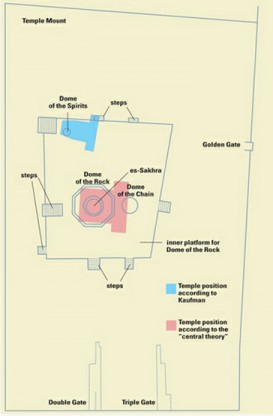
There are two other views regarding the location of the Temple in addition to the “central” theory—the southern and northern theories. Already in 1878, James Ferguson, in his The Temples of the Jews and the Other Buildings in the Haram Area at Jerusalem , suggested that the Temple stood in the southern part of today’s Temple Mount. The major proponent of this view today is architect Tuviah Sagiv. Kaufman is the proponent of the northern location, and he has spent a good many years and a good many pages in this book trying to prove this theory. Thus, according to Kaufman, the Holy of Holies was located at the site of the present-day Temple Mount cupola known as the Dome of the Spirits (also called the Dome of the Tablets) northwest of the Dome of the Rock, and the Foundation Stone is the rock under the Dome of the Spirits. Not wishing to leave es-Sakhra (the rock formation inside the Dome of the Rock) without any function, Kaufman conjectures that it was the Stone of Lost Property mentioned in the Babylonian Talmud from which announcements of found lost property were made.
Since, as mentioned above, Kaufman has been bandying this theory about for a good many years, there has already been a good deal of criticism regarding his “northern location theory.” Some of the criticism relates to Kaufman ignoring topographical and geological factors not consistent with his view. Other criticisms claim that Kaufman’s view regarding the location of the Temple makes his reconstruction of the Inner and Outer Courts of the Temple geographically and physically untenable. Finally, there are those who claim that the floor under the Dome of the Spirits is not bedrock, as claimed by Kaufman, but a large paving slab or a stone in some other type of secondary use. While Kaufman responds in the present work to some of this criticism, he is far from thorough or convincing in his replies. (In all fairness, however, it should be pointed out that accepting the views of Kaufman’s critics also require the occasional [archaeological] leap of faith.)
The second key element in understanding Kaufman’s northern location theory relates to the alignment of the Temple vis-à-vis the Mount of Olives and the ceremony of the burning of the red heifer. Mishnah Parah chapter 3 describes the ceremony from beginning until end. The red heifer’s ashes were mixed with water and sprinkled on the ritually unclean, purifying them. The burning took place on the Mount of Olives, and the priest officiating directed his view to the entrance of the Sanctuary ( Hekhal ). The eastern wall of the Temple Mount was lower than the others to facilitate this view (Mishnah Middot 2:4; Babylonian Talmud Middot 16a). To determine the approximate location of the Temple, theoretically, all that one must do is to find the spot on which the priest stood and determine his line of vision. This is what Asher Kaufman does in his new volume (and has been doing for a good many years), and this line of vision led him to his northern identification. The only problem is that, with all due respect to the calculations of the author, it is impossible to know where the priest stood on the Mount of Olives. In a previous study, Kaufman suggested that the priest stood near the present-day Church of the Ascension. Others have preferred placing the priest in the area below, near where the Church of Dominus Flevit stands today. When all is said and done, though, Talmudic tradition does not really provide us with enough information about the location of the red heifer ceremony. 4
Once Kaufman has located the Temple, he moves on to its alignment and plan, as well as to the Inner Court ( ‘Azarah ) and the “Sanctified Outer Court” ( Har Habbayit ). All of this is superimposed, a number of times, on the present-day Temple Mount. For the most part this consists of analyzing literary sources in light of “archaeological” findings, which are part groups of rock-masses that cannot be dated with certainty to the Second Temple period. Sometimes this results in very strange conclusions, such as the placing of the Chambers of the Court of Women outside the Court of Women (pp. 84–85). However, an analysis of Kaufman’s views on these rock-masses, literary sources and subsequent reconstructions would take far more space than allowed here. There is much here that has and will elicit criticism and response.
This book does not make for easy reading, although in Kaufman’s defense it should be pointed out that he makes every effort to be reader-friendly, providing numerous illustrations and explanations. The subject matter is highly technical and detailed, and nothing can be done about this. Also, while Kaufman does make reference to his critics and their criticisms, he does not sufficiently respond to their comments and this is not fair to the reader.
In spite of the above, Asher Kaufman is one of the foremost scholars of the Jerusalem Temple. While one might quibble about this or that reconstruction or calculation, it is important to remember that outside of the world of scientific scholarship, there is a vibrant industry of pseudo-scientific Temple and Temple Mount material being produced and disseminated with great success. While the issues might be complex, it is easier and faster to fantasize than to engage in the type of painstaking research that Asher Kaufman undertakes. We eagerly await his future publications. While we may disagree with him at times, his ongoing contribution to Temple and Temple Mount scholarship cannot be denied.
1. Asher Selig Kaufman, The Temple of Jerusalem, Part I: Tractate Middot: An Annotated Version Composed from Manuscripts and Early Printed Texts with Introduction, Variant Readings, Family Tree of Texts, Notes and Temple Drawings (Jerusalem: Har Year’ah Press, 1991, in Hebrew); Part II: Tracate Middot: Variant Readings for Chapters 1 and 2 Presented in Novel Form as a Transcript of Manuscripts and Early Printed Texts (Jerusalem: Har Year’ah Press/Gefen, 1997, in Hebrew).
2. The literature is voluminous and beyond the scope of this review. For a good summary of the various theories see Leen and Kathleen Ritmeyer. Secrets of Jerusalem’s Temple Mount (Washington, D.C.: Biblical Archaeology Society, 1998).
3. Arye Ben David, “Ha-Midda ha-Yerushalmit,” Israel Exploration Journal 19 (1969) , pp. 159–169; Ben David “The Hebrew-Phoenician Cubit,” Palestine Exploration Quarterly 110 (1978) , pp. 27–28. See also Yehoshua Peleg, The Metrology of the Medium Size Cubit from Herod’s Time to the Third Century , unpublished MA dissertation, Bar-Ilan University, 2003, in Hebrew.
4. See Ya’acov Eshel, “Where Did the Kohen Stand on the Mount of Olives?” Judea and Samaria Research Studies, Proceedings of the Seventh Annual Meeting 1997 (Kedumim-Ariel: The Research Institute, The College of Judea and Samaria, 1998), in Hebrew, pp. 93–105.
a. The Mishnah is an early Rabbinic law code and forms the basis of the Babylonian and Jerusalem Talmuds.
Joshua Schwartz is dean, faculty of Jewish studies and director of the Ingeborg Rennert Center for Jerusalem Studies at Bar-Ilan University, Israel. He also heads the “Jerusalem Reborn” research project, which seeks to create a virtual reconstruction of the Herodian Temple and Temple Mount.
Related Posts

Review: Ancient Synagogues Revealed 1981–2022
By: James Riley Strange

Review: An Anatomy of God
By: Erin Darby

Review: The Magi in History and Tradition
By: Christopher A. Frilingos

Review: What New Testament Women Were Really Like
By: T.J. Wray
Write a Reply or Comment Cancel reply
Your email address will not be published. Required fields are marked *
Recent Blog Posts
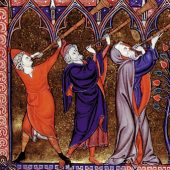
Aaron in the Bible

Alternative Facts: Domitian’s Persecution of Christians

New Frescoes Discovered at Pompeii
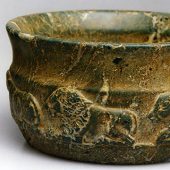
10 Great Biblical Artifacts at the Bible Lands Museum Jerusalem
Must-read free ebooks.
50 Real People In the Bible Chart

The Dead Sea Scrolls: Past, Present, and Future

Biblical Peoples—The World of Ancient Israel

Who Was Jesus? Exploring the History of Jesus’ Life
Want more bible history.
Sign up to receive our email newsletter and never miss an update.
By submitting above, you agree to our privacy policy .
All-Access Pass
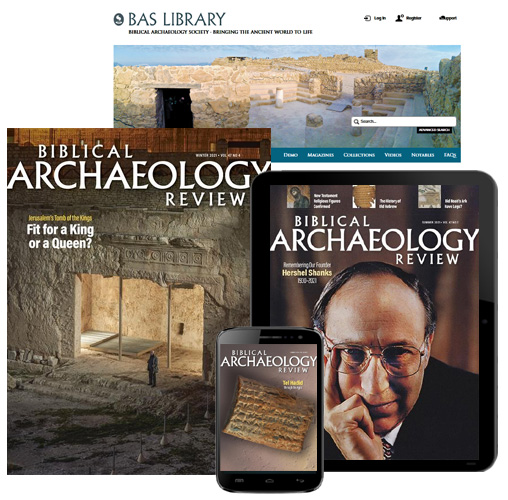
Dig into the world of Bible history with a BAS All-Access membership. Biblical Archaeology Review in print. AND online access to the treasure trove of articles, books, and videos of the BAS Library. AND free Scholar Series lectures online. AND member discounts for BAS travel and live online events.
Signup for Bible History Daily to get updates!

IMAGES
VIDEO
COMMENTS
Visiting the Temple Mount. Visitors enter the Temple Mount complex through the Mughrabi Gate near the Western Wall. Many people will see the entrance as they walk through the Western Wall plaza on a tour of the Old City. While admission is free, the site is only open during very specific times. Because of this, the line can be very long to enter.
Visiting hours for the Temple Mount are Monday through Thursday: Winter: 7:30 am - 10:30 am and 12:30pm - 1:30 pm. Summer: 8:30am - 11:30am and 1:30pm - 2:30pm. The Temple Mount is closed to visitors on Friday and Saturday. It may also be closed without notice for security reasons.
To find it, look for an elevated wooden walkway by the Western Wall. Head up that and you'll eventually arrive at the security check for the entrance. 🌿 Travel Tip: The Dung Gate into the Old City of Jerusalem is the nearest gate to Temple Mount. You can also get there from the Lion's Gate or the Chain Gate.
1 | The Entrance to Temple Mount. Temple Mount can be accessed by 11 gates in the Old City of Jerusalem but tourists and non-Muslims are only allowed to enter through the Moroccan Gate which is also known as Mugrabi Gate. This gate is located near the Western Wall Plaza close to Dung gate. The wooden walkway marking the non-Muslim entrance to ...
In the summer (April to September), you can visit the place between 8:30 AM - 11:30 AM and then 1:30 PM - 2:30 PM. In the winter (October to March), the visiting hours are pushed one hour back, so it is possible to go inside between 7:30 AM - 10:30 AM, and in the afternoon, 12:30 PM - 1:30 PM.
Temple Mount and the Dome of the Rock are located in the Old City of Jerusalem. The only entrance for non-Muslims and tourists is via a walkway located outside the Western Wall, near Dung Gate. The entrance is known as Moroccan Gate, or Bab al-Maghariba gate. There are other gates scattered around the Old City, exclusively for use by Muslims.
The simplest way to reach the tourist entrance is by entering the Old City through the Dung Gate (lower-left corner in the photo above). Then you continue straight along the fence of Davidson Center until you reach the security checkpoint. ... The Temple Mount is an important site, but it never underwent archaeological excavations. In 1999, the ...
Winter hours are 7:30-10:30am and 12:30-1:30pm. Summer hours are 8:30-11:30am and 1:30-2:30pm. However, the entrance can be closed without notice even during normal hours, so I recommend getting on the TripAdvisor forums right before your trip to make sure things haven't changed.
The visiting hours of Temple Mount are pretty short, so you've got to take note of the timings for a successful visit. The entrance to Temple Mount. Unfortunately it was closed when we were there. It also took us awhile to figure out where the entrance to Temple Mount was. I later realised that the entrance is located at the Western Wall.
The Islamic shrine Dome of the Rock is found on a holy site in Temple Mount, a protected area in Jerusalem's Old City. The Dome was initially built in 691CE under the order of Umayyad Caliph Abd al-Malik on the site of the Second Jewish Temple but was destroyed during the Roman siege of Jerusalem in 70CE. The original dome was then rebuilt in ...
Visiting the Dome of the Rock requires planning, as the open hours center around hours of Muslim prayer. The hours are different in winter and in summer for this reason. It's advised to check the schedule before working a trip to Dome of the Rock into your day, but we did not have a problem. For the 1pm opening, we arrived at 12pm on the dot ...
The Mercy Gate, 257 m north of the south-eastern corner of the Temple Mount, is the most beautiful of all the gates of Jerusalem. It is approached from within the Temple Mount by twenty-two stairs, which lead into a magnificent entrance, decorated with unusually intricate carvings of acanthus leaves, which appear to be moving.
The Temple Mount is the place where past Jewish temples are commonly believed to have stood, which places it, along with the nearby Western Wall, among the holiest sites in Judaism. ... The Mughrabi Gate is the only entrance to the Temple Mount accessible to non-Muslims. Jewish attitudes towards entering the site ...
Temple Platform Temple Platform . The site of Solomon's First Temple is now a spacious plaza. The western side features some arcaded Mameluke-era buildings. Between the gates of Bab al-Qattanin and Bab el-Hadid are a number of tombs, including that of Sharif Hussein I Ibn Ali (1851-1931), leader of World War I's Arab Revolt.
The entry restrictions for tourists, showing opening times and a Rabbinic warning. A view of Temple Mount from south side. Israeli Police guard an entrance to the Temple Mount. At present, the Government of Israel controls access to the Temple Mount, also known as Al-Aqsa Mosque compound, in East Jerusalem 's Old City, which is a holy place for ...
The Temple Mount is the trapezoid-shaped, walled-in area in the southeastern corner of the Old City of Jerusalem.The four walls surrounding it date back - at least in their lower parts - to the time of the Second Jewish Temple, built at the end of the first century BCE.These massive supporting walls, partly buried underground, were built around the summit of the eastern hill identified as ...
Opening hours. During summertime, the visiting hours from Sunday to Thursday are 8.30 a.m. to 11.30 a.m. and 1.30 a.m. to 2.30 p.m. During wintertime, the opening hours are different than in summer and are from 7.30 a.m. to 10.30 a.m. and from 12.30 p.m. to 1.30 p.m. For security reasons and as a safety measurement Mount Temple Jerusalem can be ...
The Temple Mount is the holiest place for the Jewish people and the only place, according to Halacha, where the Third Temple could reside in the future. The Jews pray in its direction three times a day and pray for the establishment of the Third Temple. The mountain on which the Al-Aqsa Mosque and the Dome of the Rock stand today is the third ...
View of the Temple Mount. The wooden bridge is the only tourist entrance, which leads up to the Mughrabi Gate. Al-Aqsa mosque, built in 705 A.D. The Dome of the Rock was built between 689 - 691 A.D. The Dome of the Chain is on the right, built in 691 A.D. Iznik tiles, ceramic tiles from Turkey. Entryway. If you aren't Muslim, you aren't getting ...
We begin at the entrance to the Temple Mount at Mugrabi Gate, next to the Western Wall plaza, one of nine open gates of the Temple Mount The Temple Mount in its present form was built by Herod during the second temple period and its size today, as it was then is 144 dunams (35.5 acres). More than 100 Islamic buildings were originally built on ...
Temple Mount. A hill in the eastern part of Old Jerusalem is of special significance to the world's three major religions. It was reputedly the site of the first and second Jewish Temple, and since the 7th century has contained two Muslim shrines. Suggest edits to improve what we show.
The burning took place on the Mount of Olives, and the priest officiating directed his view to the entrance of the Sanctuary (Hekhal). The eastern wall of the Temple Mount was lower than the others to facilitate this view (Mishnah Middot 2:4; Babylonian Talmud Middot 16a). To determine the approximate location of the Temple, theoretically, all ...